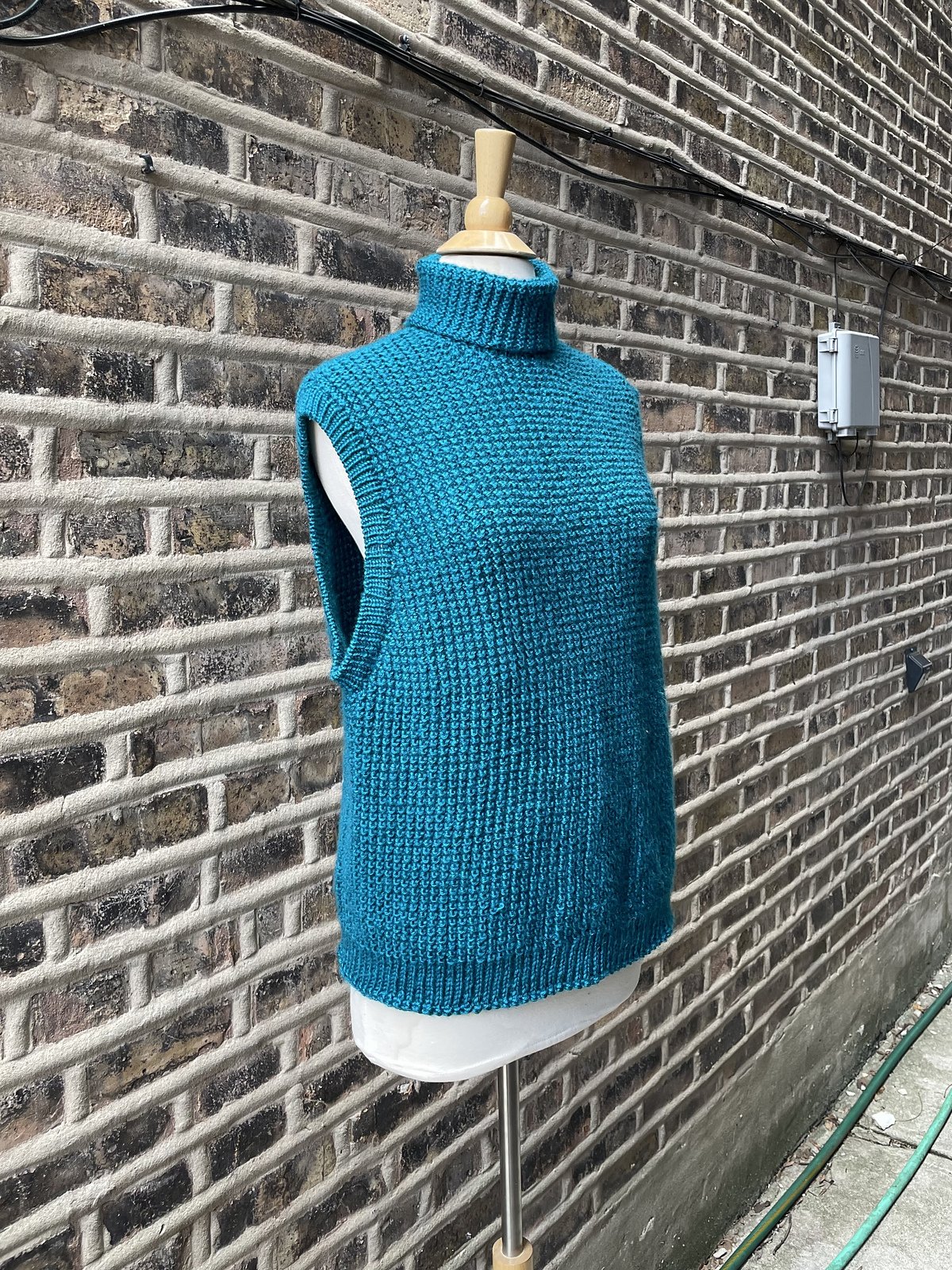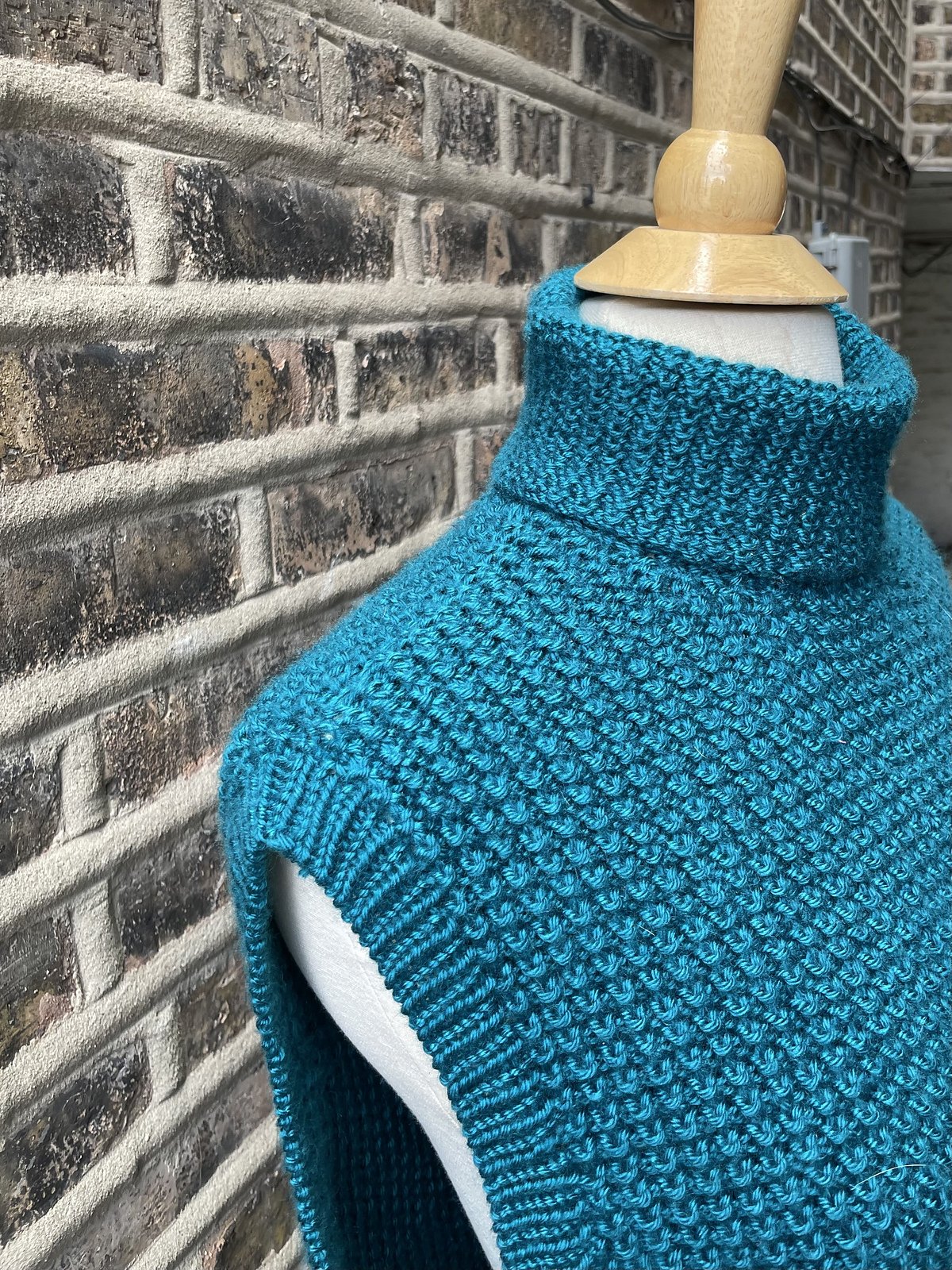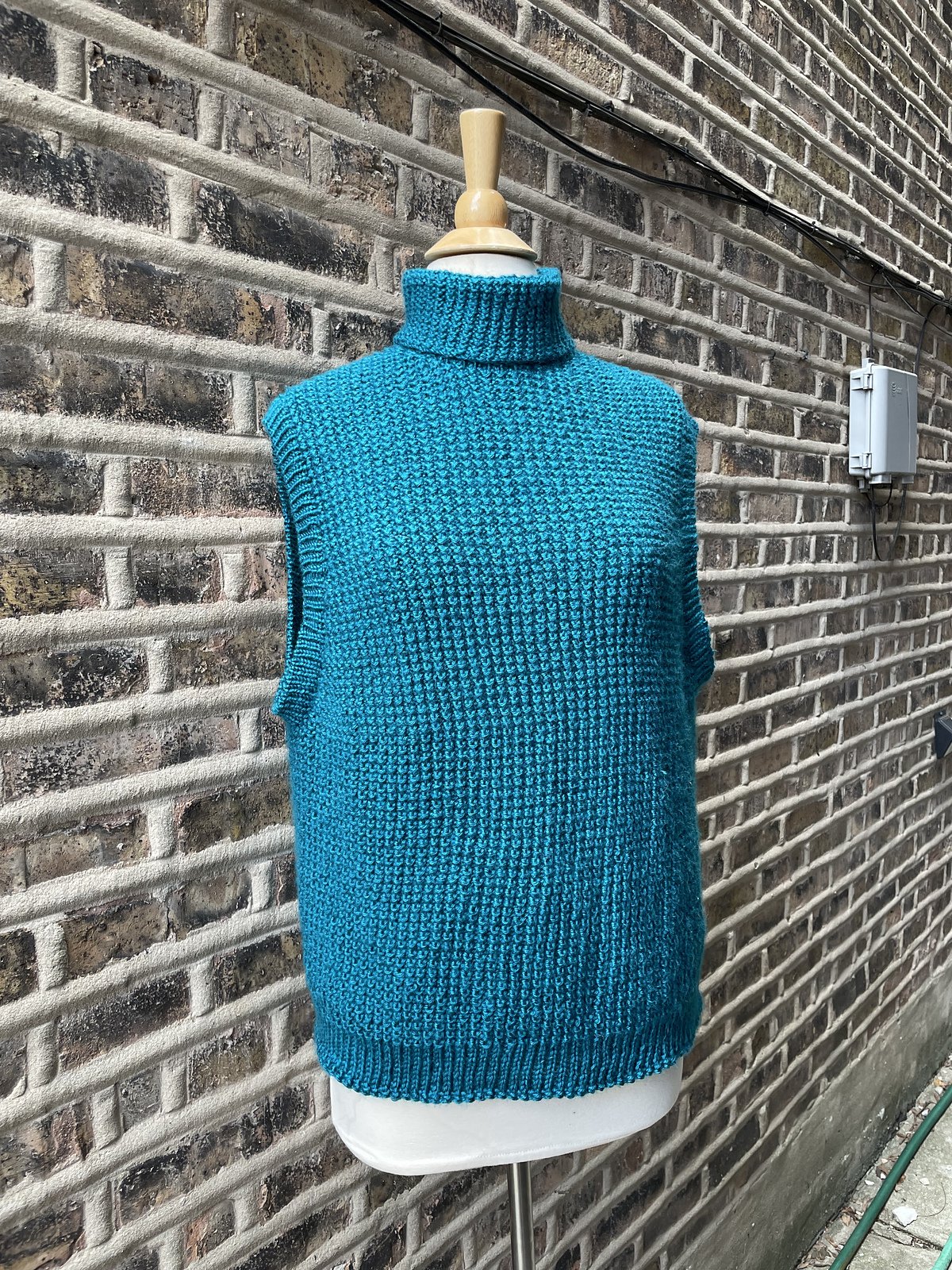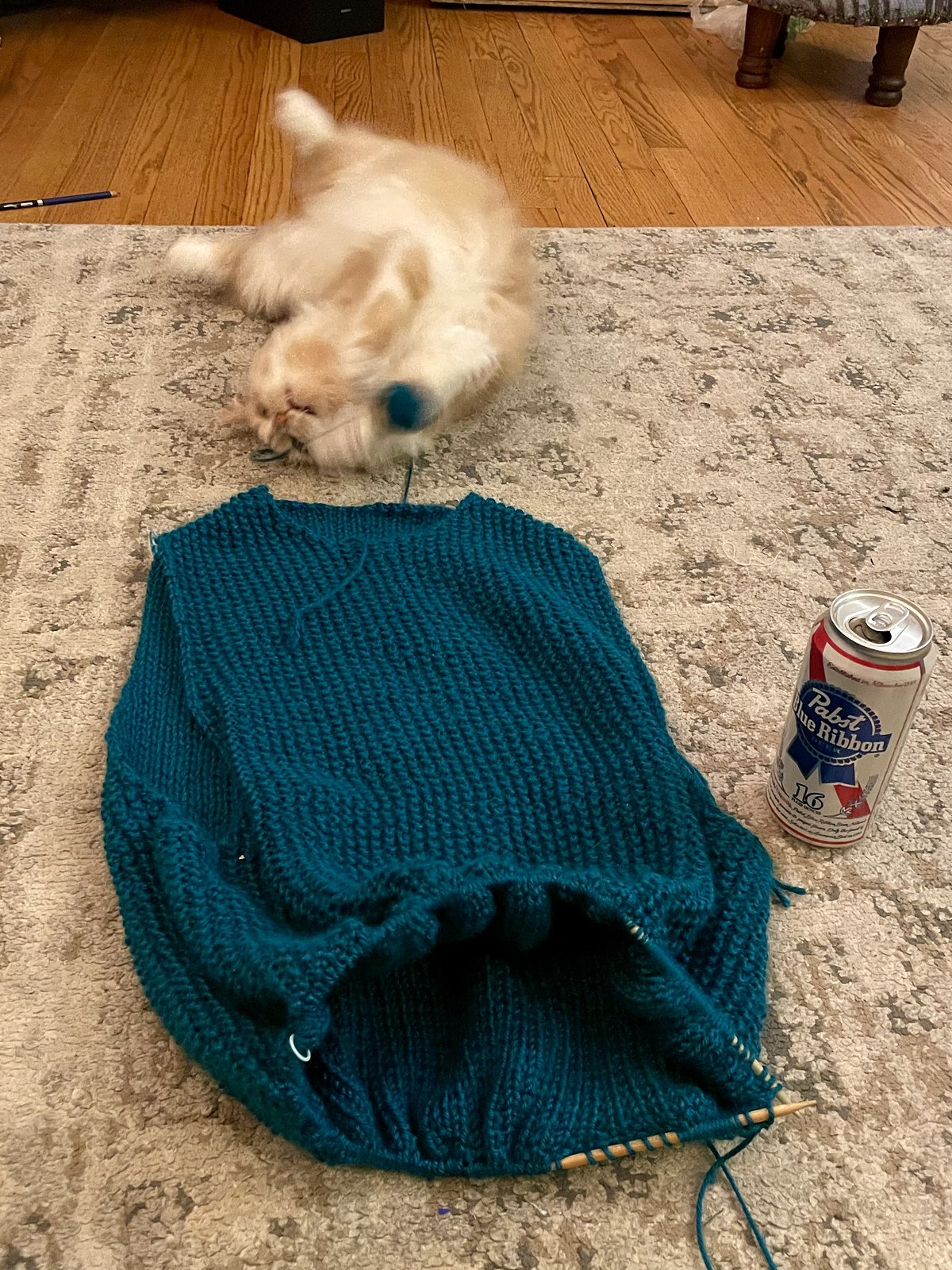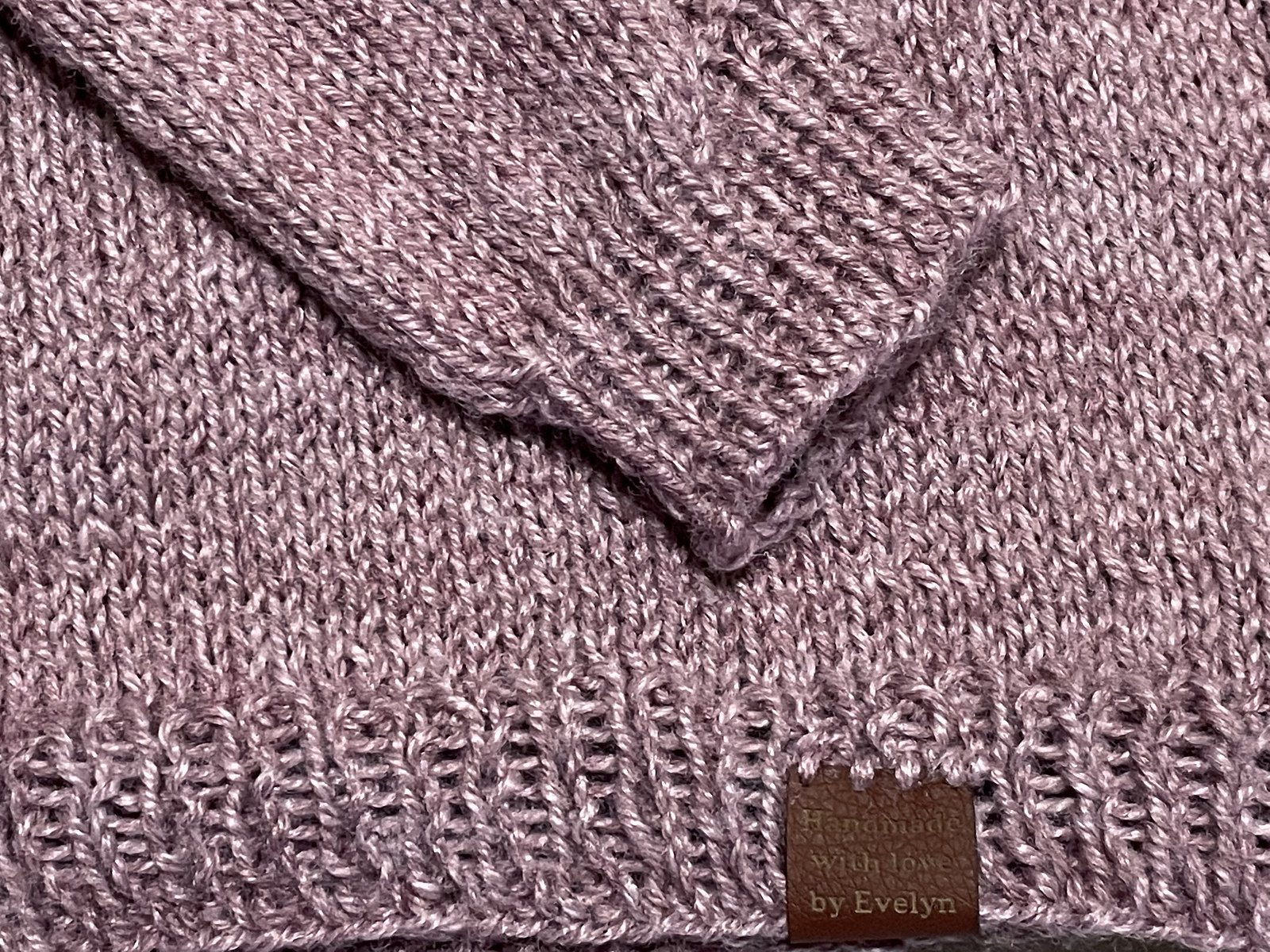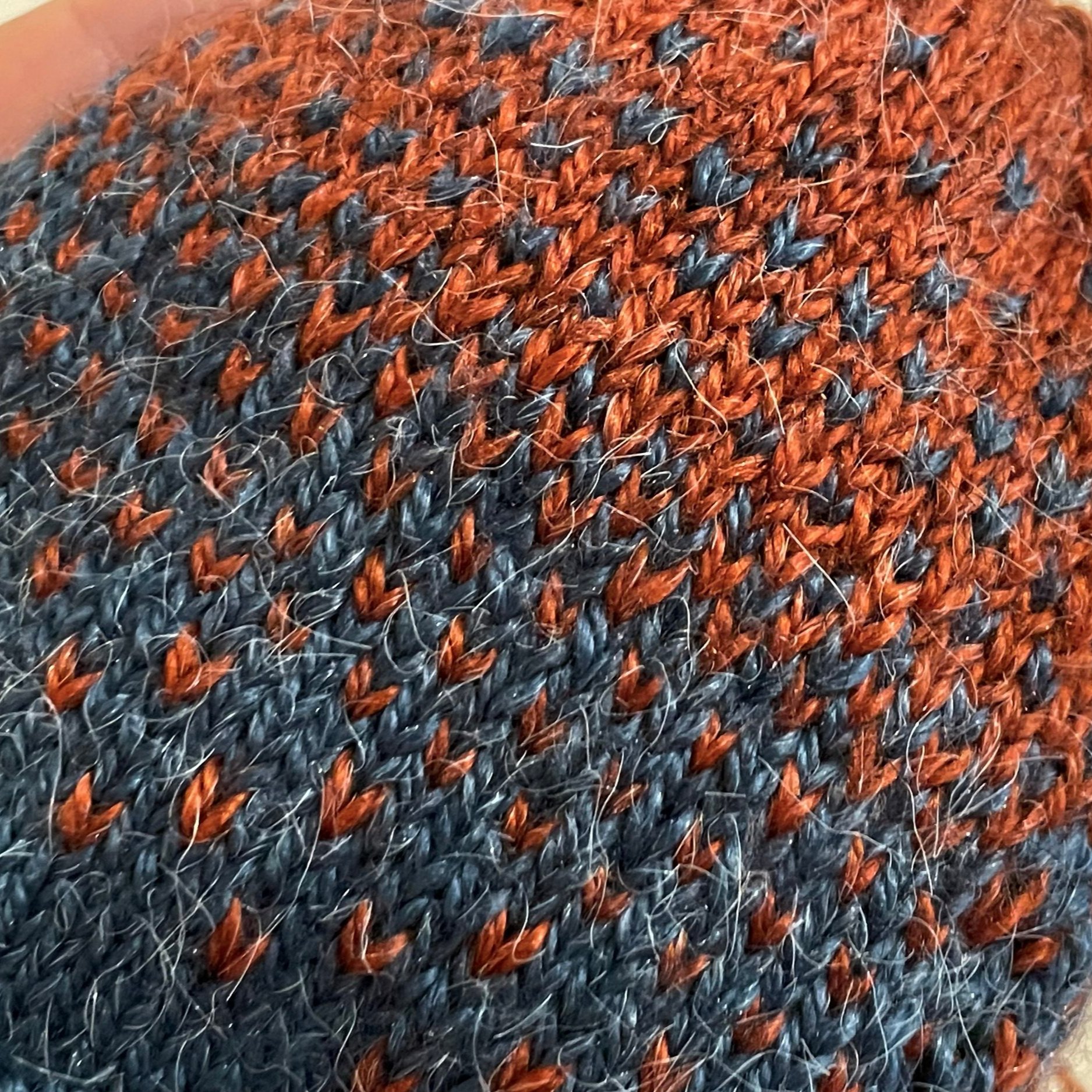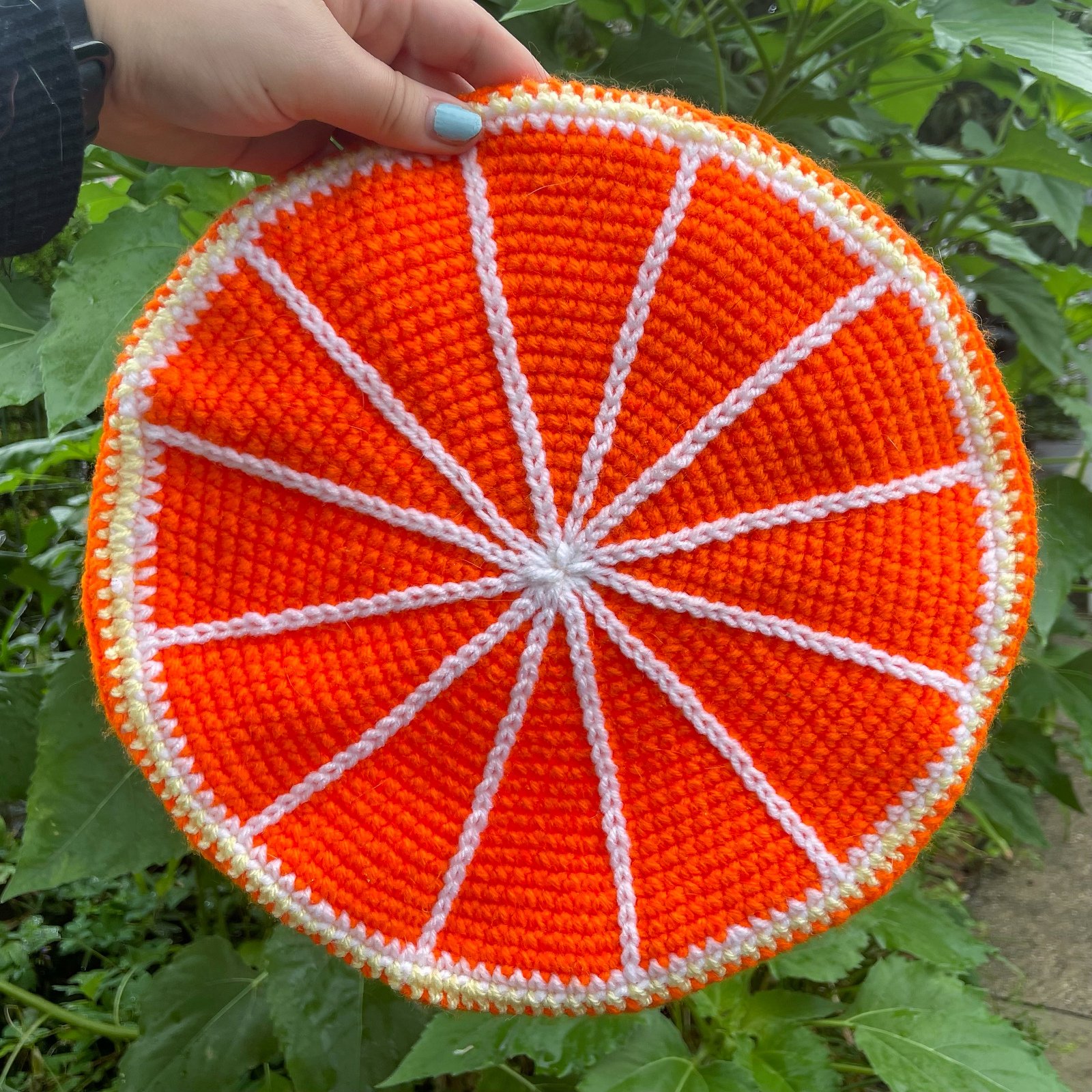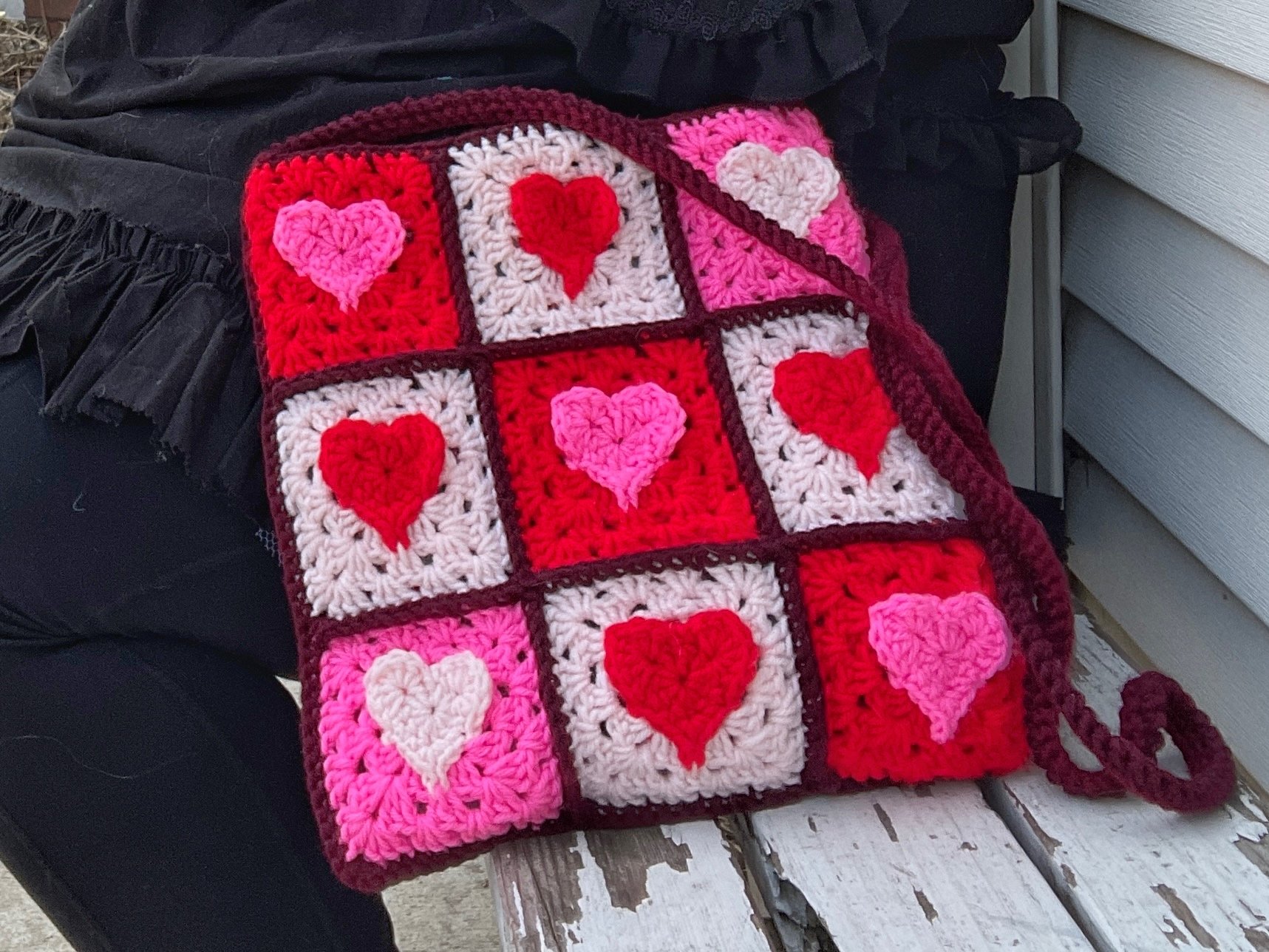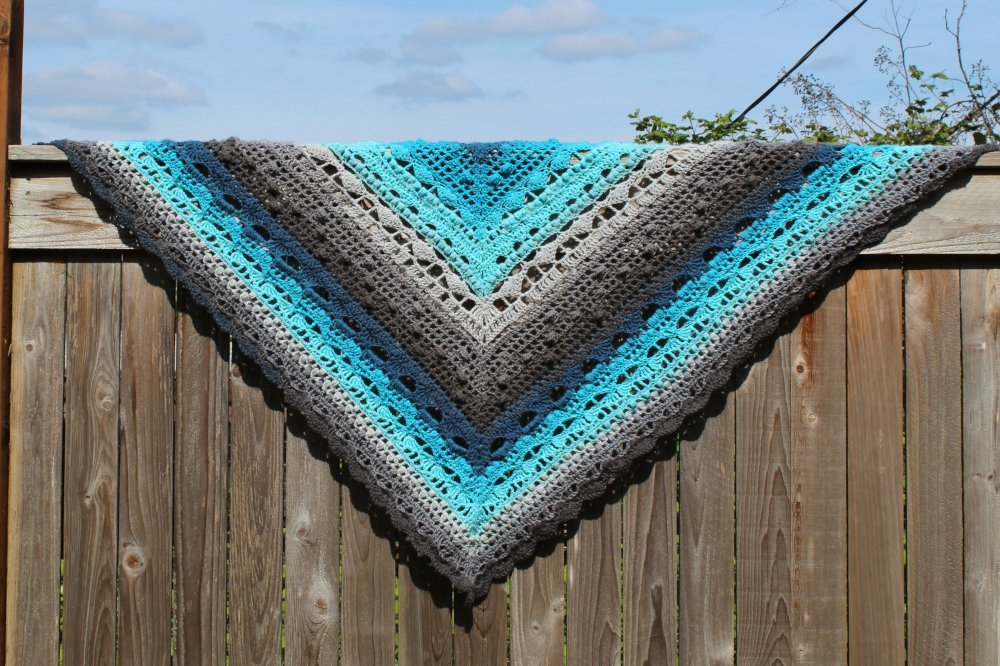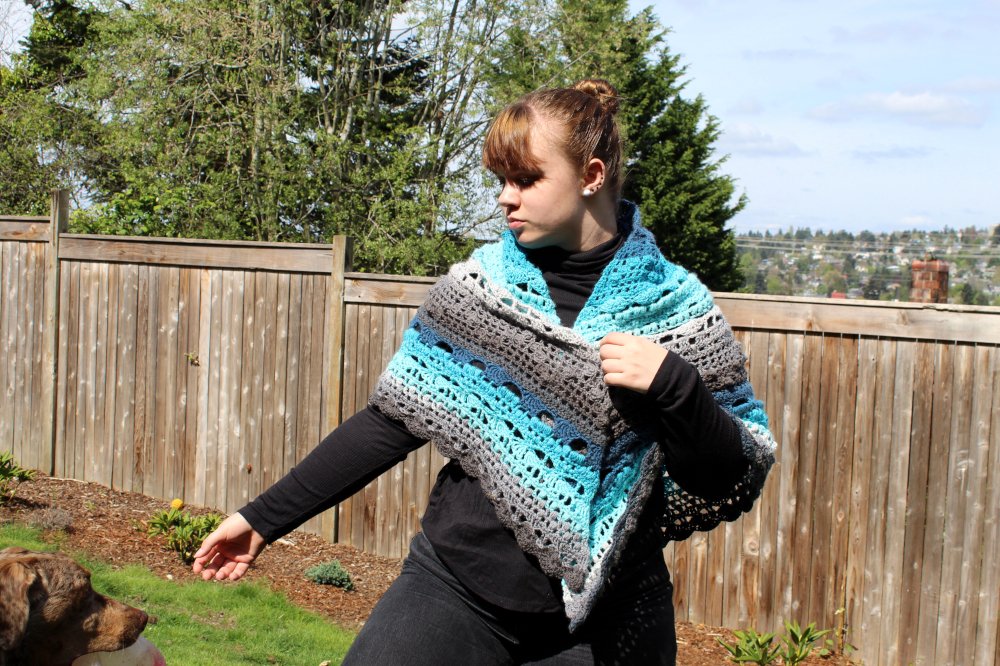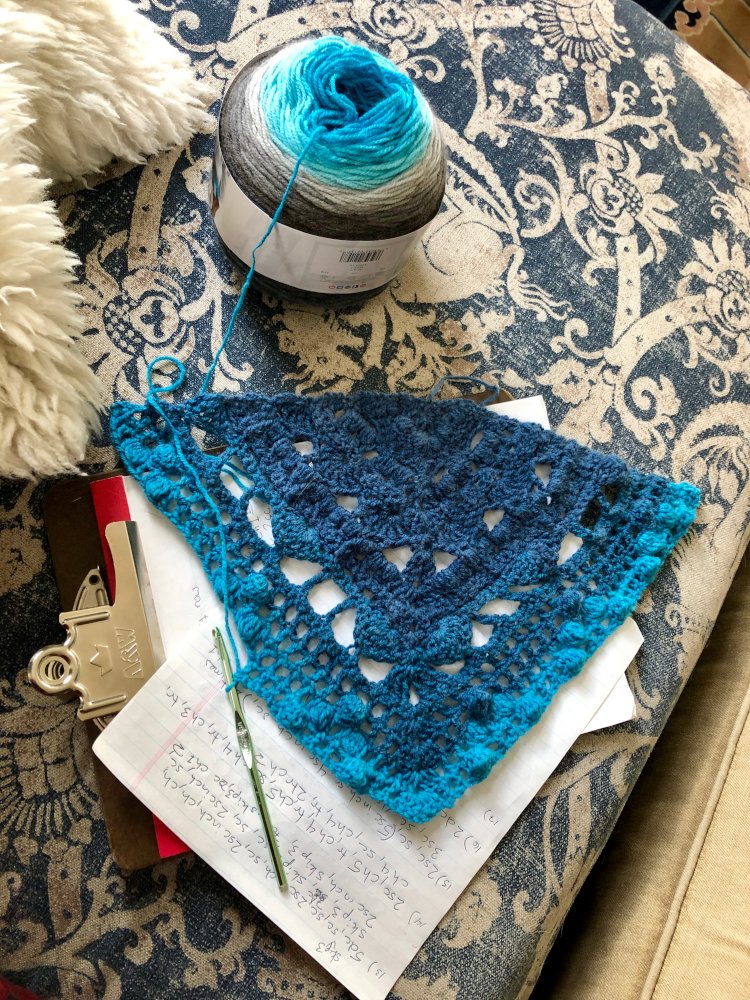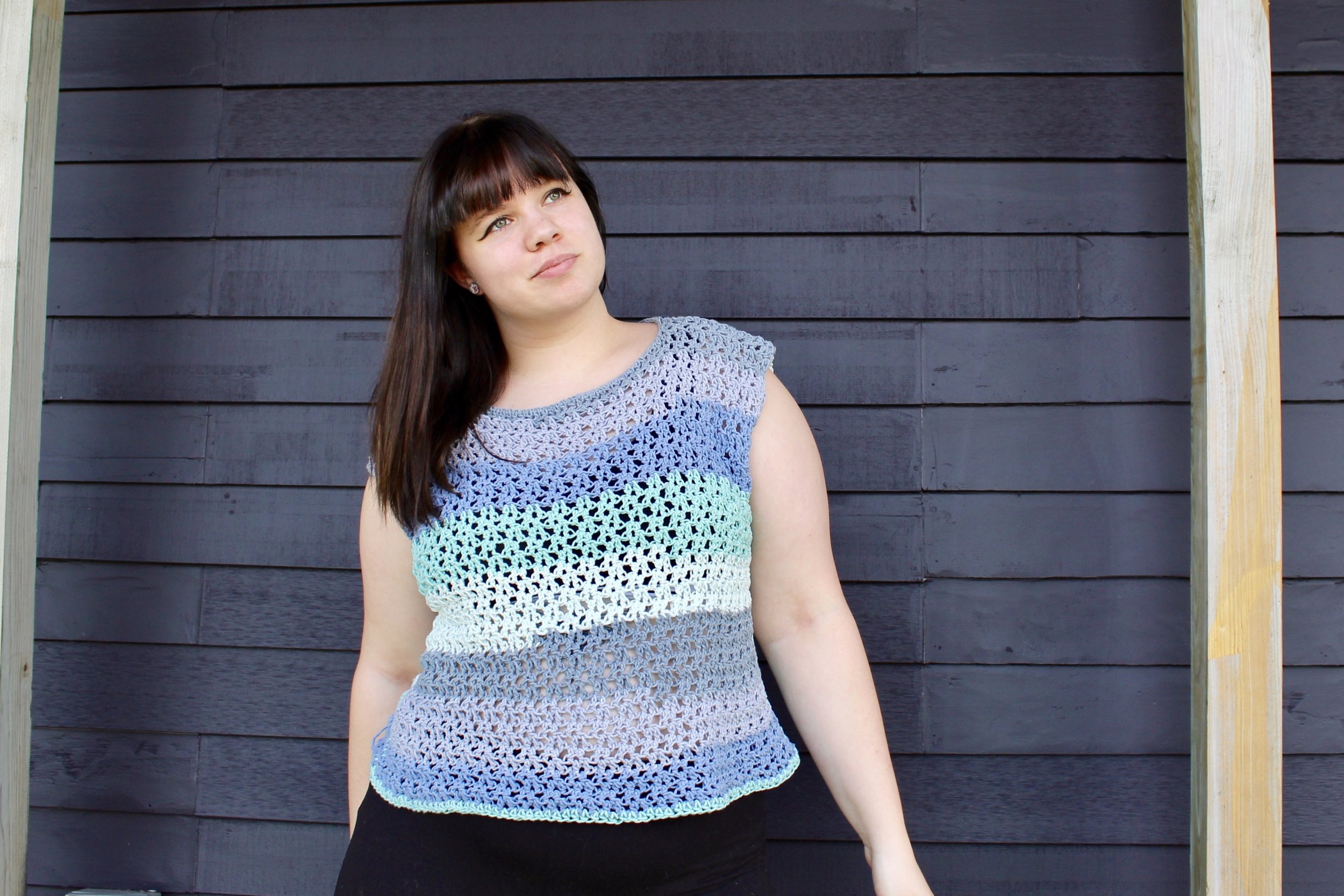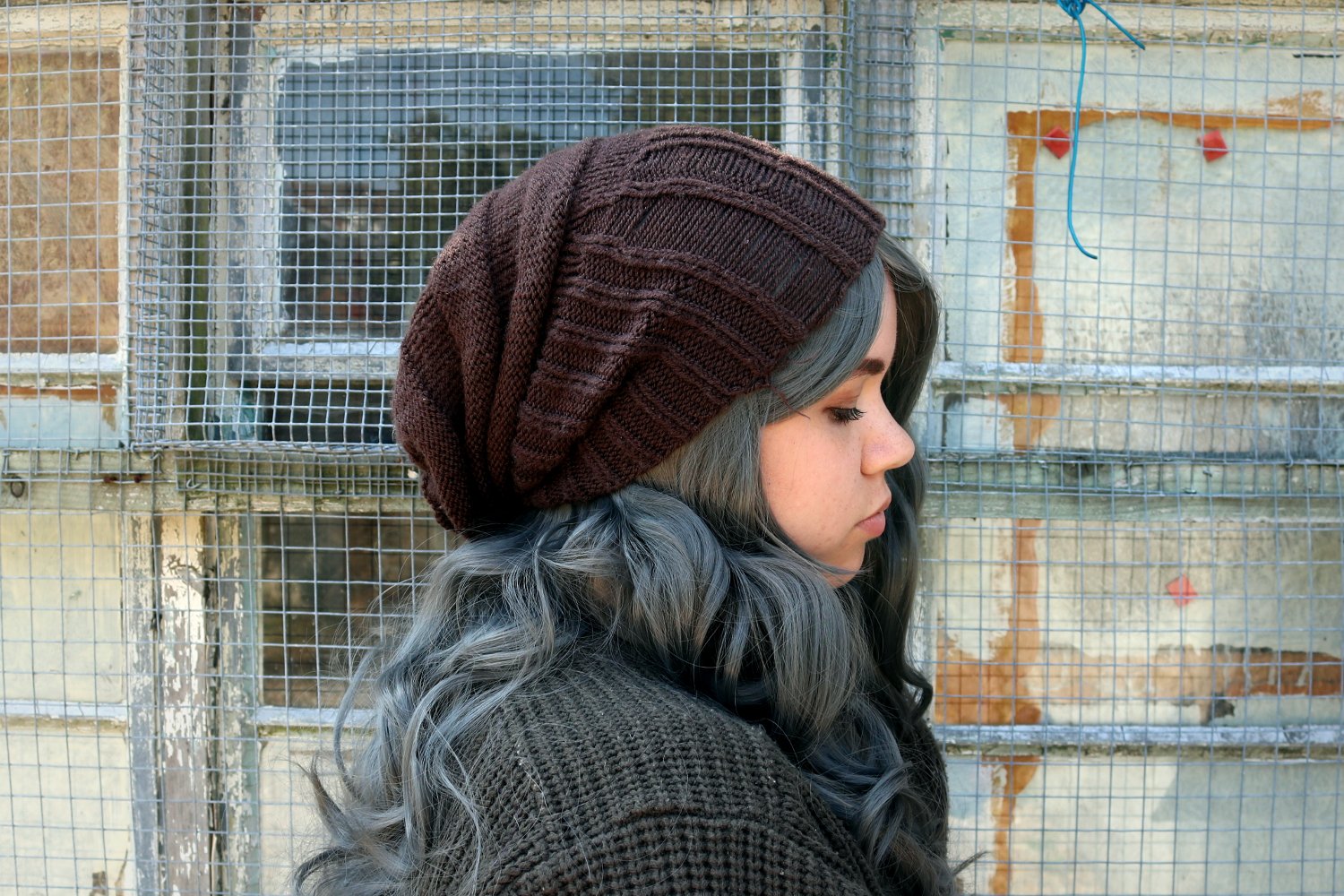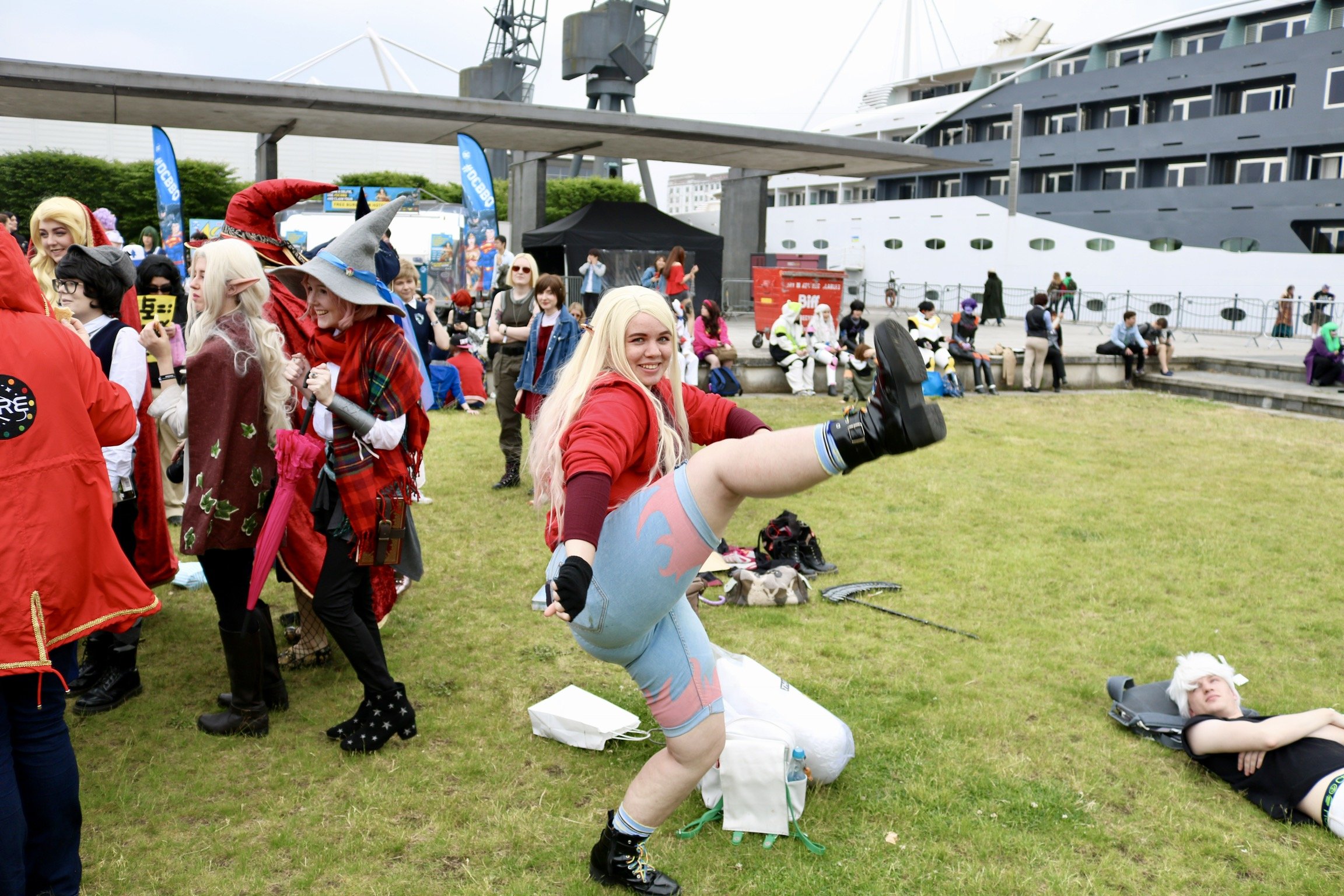Femøren by Sanne Bjerregaard
Since making the Belle Vest, I’ve been on a bit of a hunt for another vest pattern to make. When I saw Femøren by Sanne Bjerregaard I knew that it was the perfect vest project for some stash busting!
I have had three skeins of Caron Simply Soft in Pagoda sitting in my stash for nearly four years. I received this yarn as part of a Reddit Secret Santa many years ago, and it has just been waiting for the perfect project to come along. As a bonus, teal is one of my girlfriend’s favorite colors, so it was great to be able to use it in a project for her!
From swatching, I was able to determine that I should use 5mm needles for the body, and 3.25mm needles for the rib. I knit rather tightly, so predictably, I sized up both needles. I liked how my swatch looked so much I ended up keeping it! However this means I have to figure out what to do with my growing swatch collection…
This vest was knit top down. Generally, I have preferred making sweaters and vests from the bottom up. In my opinion, it it a lot easier to do neck shaping when the garment is worked flat. This vest, however, used a new technique that I hadn’t seen before. Every other time I have knit a top down sweater, I have cast on all of the neck stitches in the round, worked the ribbing, and then done shoulder/neck shaping. For this vest, about half the neck stitches are cast on and the piece is worked flat. Stitches are added strategically for neck and shoulder shaping until the fabric is long enough to be joined in the round, making both the cast on edge and the sides of the work into the neck hole. The collar is picked up and knit at the end.
At first, I found this style of neck very confusing and wasn’t sure if I was even going to get a garment out of it, but I persisted and it started looking more like clothing as I went. The result is some of the best neck shaping I’ve ever had on a top down sweater, and a very clean look to the shoulder. Now that I’ve done it, I think this would be my preferred construction method for a top down sweater!
The only real deviation I made from the pattern was to use the larger needles for the rib at the bottom of the sweater, and to use a stretchy bind off for that edge. I did this because I didn’t want the bottom of the vest to cinch in and instead to hang straight down.
I really can’t figure out why, but this yarn seemed particularly attractive to the cats. My kitty would not stop trying to lie on it at every opportunity. When I brought my project with me to work on at a friend’s, THEIR kitty kept playing with the ball of yarn! I know that some cats can be attracted to plastic, which 100% yarn technically is, but I’ve never had this reaction from any other acrylic yarn I’ve used. If anyone has insight into this, please let me know, I need to know the science behind this.
the Belle Vest by Rita Marques
Recently I had the opportunity to test knit the Belle Vest by Rita Marques. It is a cropped boxy fit vest that is knit from the bottom up. I would consider this a great pattern for someone considering making their first sweater. Yes, it doesn’t have sleeves - but I think this makes it better for someone just learning to make wearables. The pattern itself includes links to video tutorials of techniques, which is fantastic for someone relatively new to knitting.
I made the vest in size 6, which turned out true to size. I did a little bit of messing around with needle sizes to obtain gauge on this one. I generally consider myself a bit of a “tight” knitter, so it wasn’t a surprise that I needed to size up the 4.5 mm needles to 5 mm needles. I was a bit surprised that I was able to use 6mm needles to obtain gauge in pattern, though. I think this is likely because I only had plastic circulars of that size, and my gauge is often looser on plastic.
It’s possible my yarn choice also had something to do with the gauge. The pattern calls for Drops Kid Silk or Drops Flora held together with Drops Air. Unfortunately for me, I’m allergic to sheep’s wool, which is used in both Flora and Air. Instead of using Drops yarn, I fell back on my favorite acrylic, Joann’s Big Twist. Theoretically the thickness of the yarn should match up, and since my gauge didn’t need too much adjusting, I assume the difference in yarn weight is negligible.
I only made two deviations from the pattern for this project. The first one is pretty obvious, especially if you’ve already clicked through to look at the pattern (which you should do!). I opted to use intarsia in the round to make a large check pattern in this vest. I’ve used this technique on other projects and knew it would make little difference in regards to the actual pattern of the vest. The fit and texture stays the same, the only thing that changes is the color - and the amount of ends I need to weave in!
The other change I made, while technically an option in the pattern, still bears a mention. When picking up the ribbing for the sleeves, I picked up maybe 10 stitches less than the pattern recommended for my specific size. In the photos above, you can see how the fit of the vest changed with the ribbing. I believe the gaping in the armholes was caused, in part, by my sloped shoulders. In general, I dislike making myself wearables because my shoulders and arms are very hard to fit. I always have to make changes. This pattern is great because reducing the number of stitches in the ribbing was such a minor change, and the only change I had to make to the fit. With sweaters I usually have a bit of a nightmare process where I have to modify the shoulder, the armhole and the sleeve width. This was considerably easier.
The last thing I wanted to mention about this vest was a new-to-me technique, the three-needle bind-off! It was used in the shoulders of the Belle Vest and I absolutely love the results! It looks super crisp from the outside, and on the inside it is very neat, looking almost like a chain stitch. I’m definitely adding this to my repertoire of preferred cast offs.
The Belle Vest was such a quick make, with such a beautiful result, it’s really made me want to make more vests!! I’ve been wearing it nonstop since I took it off the needles. Did you know Rita has another vest design in her pattern portfolio? Be sure to check out her designs, and let me know what you make!
Happy crafting!
Needle & Yarn Charts
I have long been frustrated by the crochet hook, knitting needle, and yarn weight size charts that are available online. I have tried to remedy some of the issues I have by making my own charts. Hopefully these are easy to read and fairly comprehensive, but I am always open to suggestions to make them better!
Simply click on either chart to be taken to a downloadable version!
Feels Like Alpaca!
While I was in New Zealand, my girlfriend picked out some yarn so that I could make her parents some hats for Christmas. Something about making winter gear for a summer holiday seemed odd to me but I wasn’t about to pass up a chance to do some knitting! She picked out Lion Brand’s new Feels Like Alpaca in Denim and Rust.
This yarn is new to me, and I also believe new to Lion Brand. I don’t usually go for Lion Brand yarns, although I can be caught admiring the pretty colors in their Mandala line from time to time. The last time I bought Lion Brand, it was their 100% recycled polyester Re-Spun yarn in Blush. That yarn was super pretty - it had a nice drape, good stitch definition, and appears to have held up pretty well in the (machine) wash over time.
The Lion Brand Feels Like Alpaca yarn is another hit! It feels surprisingly close to alpaca! I think it definitely looks like alpaca, and feels very soft. I’m not sure if it’s just because I touch so much yarn, but it does feel synthetic to me. Without the label, I’d assume it was some kind of alpaca blend. With the label, I know that it is 87% acrylic, 7% polyester, and 6% nylon. It’s also machine washable, which is a big plus in my book!
I found this yarn to be a bit slipperier than most synthetic yarns I use, although I found it would catch on the lettering of my DPNs. I used Crystal Palace size 3 (3.25 mm) bamboo needles for the entirety of both of the hats that I made. I found that it was fairly easy to undo stitches, but was a bit prone to being split with a knitting needle while working with it. Despite the yarn being fuzzy I still felt the stitch definition was pretty good - better than most alpaca I’ve worked with. I assume this has something to do with the synthetic nature of the fibers.
Would I buy it again? Probably! I really like the feel and look of this yarn, and I do like the Burgundy colorway a lot! The only issue I’m seeing is that the color palette isn’t super varied. Every color is gorgeous, but I would love to see a green, or a brown, or more of a true red or purple. If there was a dark slightly desaturated purple it would already be in the mail on its way to me.
Possum Yarn
I’ve just got back from New Zealand! There’s many exciting things to say about that but what I’m focusing on here is a specific yarn I found.
New Zealand is famously known for their sheep. They’re a large exporter of both meat and wool! Pretty much any ride through the country will reveal gorgeous hills covered in sheep.
Unfortunately for me, I have an allergy to sheep’s wool. Fortunately, New Zealand has a slightly lesser-known, unique fiber that they use for yarn: possum.
It is a little tricky to find possum yarn that isn’t blended with sheep’s wool, but I was lucky enough to find Zealana’s Air yarn at Knit World in Wellington. Possum fur has pretty short fibers and needs to be combined with other fibers to create a better yarn. This yarn is blended with cashmere (goat!) and mulberry silk.
Zealana’s site does a much better job of explaining it, but possums here are pests. The brushtail possum is native to Australia but invasive to New Zealand. They cause a lot of damage here by eating native bird species’ eggs out of their nests and by destroying native plants.
I personally prefer to work with yarn in the DK-chunky range, so lace weight was new to me. I scoured ravelry for a while before settling on the Fir Cone Cap by Sarah Pop. The yarn is very soft, and quite slippery so I opted for a pattern that used a needle size larger than what I had on hand. That is to say, I knit this hat using US size 3 (3.25 mm) needles.
The asymmetrical brim was neat and looked pretty, although likely not something I’d personally do again. I generally prefer hats that don’t have a designated “front” or “back” because I will always inevitably put them on sideways. The lace was absolutely lovely. I’m not sure if I’ve ever done “true” knit lace before, but this pattern was super easy to memorize and worked up very quickly.
I opted to make the medium length hat, because I liked how that was sitting on my head while I was trying it on. My head is a bit on the smaller side and I prefer just a bit of slouch.
After wearing the hat about for a couple days, I have determined that this is probably the warmest fiber I’ve had the pleasure of working with. I was concerned that it would be rather insubstantial because of how light and delicate it felt, but found myself surprised and sweaty on most days. I think the possum hat might be a bit better for Chicago winters than New Zealand spring!
New Site!
Welcome to the new website for Elv Needleworks!
I had held on to the old name of “Sammich Sewing” for a long time, but I felt it no longer represented me or the products I am making. Back in 2012, when I started my first website, I thought that my primary focus would be sewing, fashion, and costuming. However, as my brand grew and changed, I always found myself changing mediums to suit whatever project I had in mind at the time. I have crochet, knit, quilted, sculpted, and so much more. I no longer focus just on garment making, but do tend to focus a bit more on needle made crafts.
I’m excited to share all the things I’m working on, as well as some crafting tips and tricks that I’m picking up along the way!
Citrus Beret
New Pattern Alert!!
The Citrus Beret is based on, well, citrus! This hat features a segmented design reminiscent of the inside of a sliced citrus fruit, with a textured underside meant to evoke the peel.
This hat is worked in the round, some details are worked directly onto the top of the hat, no sewing required!
Granny Hearts Bag
This bag is maybe a little late for this Valentine's Day, or maybe it's just really early for the next one? Whichever it is, it's a fun, textured bag that's a good use of some smaller balls of yarn!
The bag itself is made up of 18 granny squares crochet together, with a denim lining and a crochet strap. The pattern for it details how to make the granny squares, as well as how to put it all together and make a bag. A good thing about this pattern is the granny squares themselves can be used to make any other item that uses granny squares as a base!
Not only is this pattern up for sale on Ravelry, but it's now up for sale on Etsy too! Please be sure to check it out!
Stellar Sailor Dickey
Recently I was lucky enough to be a test knitter for the Stellar Sailor Dickey pattern by Paul Haesemeyer. It's definitely one I would recommend as a good weekend project - as long as you're comfortable with charted cables, this is a pretty quick knit!
I worked mine up using my favorite yarn - Joann's Big Twist. I did deviate just a touch by adding in some store bought pompoms instead of making my own, but the color was a perfect match! How could I resist?
in progress, just before joining front and back to work in the round
One of the things that I really like about this piece is that it tucks in really smoothly. Wearing it outside a coat or jacket really shows off the cables, but wearing it tucked in does an incredible job of shielding from wind and snow. I've actually already started on a second one in brown, which is going to go to my roommate.
If you haven't already, be sure to head on over to Paul Haesemeyer's ravelry page to check out his patterns!
Mushroom Beret Hat Pattern
First thing's first:
Happy New Year!


One of the last things I did in 2021 was make and design this Mushroom Beret. This is definitely in my top three designs of 2021. I made this hat using two colors of yarn and fairly simple stitches.
I've had the idea to make a Mushroom Beret for a while, but was only able to focus on this project recently. This beret’s design was inspired by amanita muscaria, or the fly agaric mushroom. One of the things that was super important to me was the look of the "gills" on the bottom of the hat. I managed to achieve what I was looking for in just a few days, and then patterned it and have uploaded it to Ravelry!
As always, thank you for reading, and be sure to share your projects when you're done!
Solstand Shawl
I picked up some Lion Brand Mandala yarn and immediately knew I wanted to make a shawl with it. The question was: which shawl? I searched for a while, but was unable to find any pattern that fit my specific vision, so I decided to design and make my own.
Over the course of about ten days, I turned my 2 skeins of Lion Brand Mandala in Spirit into a shawl and wrote up a pattern for it! This shawl pattern requires knowledge of basic stitches, as well as front post and back post stitches. The shawl uses about 1000-1200 yards of DK yarn and a size 5 mm (H) crochet hook Instructions for bobble and puff stitches are included. Scroll down to the bottom of this page for a link to purchase the pattern!
Jupiter would prefer if I didn't put my crochet on his ottoman
For the most part I was super happy with the yarn I used. It didn't become 'fuzzy' even after ripping out and crocheting repeatedly, and the colors were beautiful. Each skein had 1 complete repeat of the colors so they were easy to cut apart and match up when changing over.
My only complaint is that inside the second skein, there was a tiny knot tying two completely different shades of blue together. I'm used to yarn having a small knot in it, but I am not pleased with the color change. I ended up cutting it apart and was able to match up the colors, but it's not ideal.
However, I'd still recommend using Lion Brand Mandala for this shawl. It has good drape and stitch definition. I also think that the length of each color in two skeins creates a very nice gradient.
Click here to purchase this pattern in UK and US terms for $4.99
Use code 'autumn' to get 20% off your total pattern purchase in my ravelry store from now until Halloween 2019!
Be sure to upload a picture to Ravelry and link it to the pattern! I love seeing everyone's creations!
Scrappy Stripes Sweater
I've completed yet another pattern! This time I used a bunch of my leftover yarn bits and bobs to create a rainbow sweaters I have dubbed the Scrappy Stripes Sweater! This pattern is available as a free downloadable pdf on Ravelry.
Evelyn is sitting down wearing a rainbow crochet sweater
The sweater body is worked from the bottom up, while the sleeves are worked from the top down. Each colored stripe only uses about 80 yards of each scrap, and about 440 yards of a base color, in my case I used cream. This brings the total amount of yarn to about 1720 yards.
If you've got sharp eyes, you might notice some yarns that I have used in previous projects! The sweater is primarily made from aran weight yarn, but there are a couple dk and worsted bits snuck in there, with careful consideration as to how that would affect the gauge.
The sweater is made from dc and sc, the cuffs using the back loop only to create texture and stretch, while the sleeves use dc2tog for shape. The stripes keep their clean look using the standing crochet stitch. If you're unfamiliar with what that is, I'd recommend checking out this tutorial on Moogly.
Scrappy Stripes Sweater Side
Although the weather is a bit warm for this scrappy sweater, I still want to wear it all the time! It was fun to use up the ends of yarn and think about other projects I had made using it.
The pattern is available for free download here. I listed all the yarns I can remember here, but I can't guarantee the one you're eyeing is listed. Remember to let me know if you make something using this pattern! You can link it to the project page on Ravelry, or tag me on social media.
Tanabota Top
I've just released a new pattern for sale on Ravelry! The Tanabota Top comes in sizes XS-XXL, fitting a bust range of 32-49 inches. It uses a size L/8mm crochet hook and worsted weight yarn. It's the perfect top for summer - it's sleeveless with an open, light stitch pattern. The patterns is also fairly easy to make, using only half double crochet, chain stitch, and slip stitch.
The yarn I used is Caron Cotton Cake in Hydrangea. It's an easy to work with yarn with good stitch definition. However, the 530 yard ball I used had eight knots tying ends together in it. I've never come across a yarn with so many knots in it, but the colors are so pretty I didn't mind too much.
The Tanabota Top is worked in one piece from front to back with side seams. Here's a close up of the join between the front and back along the sides, joined with a whipstitch. I was a bit worried with the color changing properties of the yarn that my stitches might look out of place, but it blended in rather well, I think.
This pattern is currently available on Ravelry for $2.99. If you're interested in this pattern, please check it out or click here to buy it now! Be sure to share pictures of what you make, I love to see what everyone comes up with!
New Pansy Fabric!
I'm pleased to announce that I've released a new floral fabric on Spoonflower! Pansy Field is also available in a gift wrap and at a smaller scale.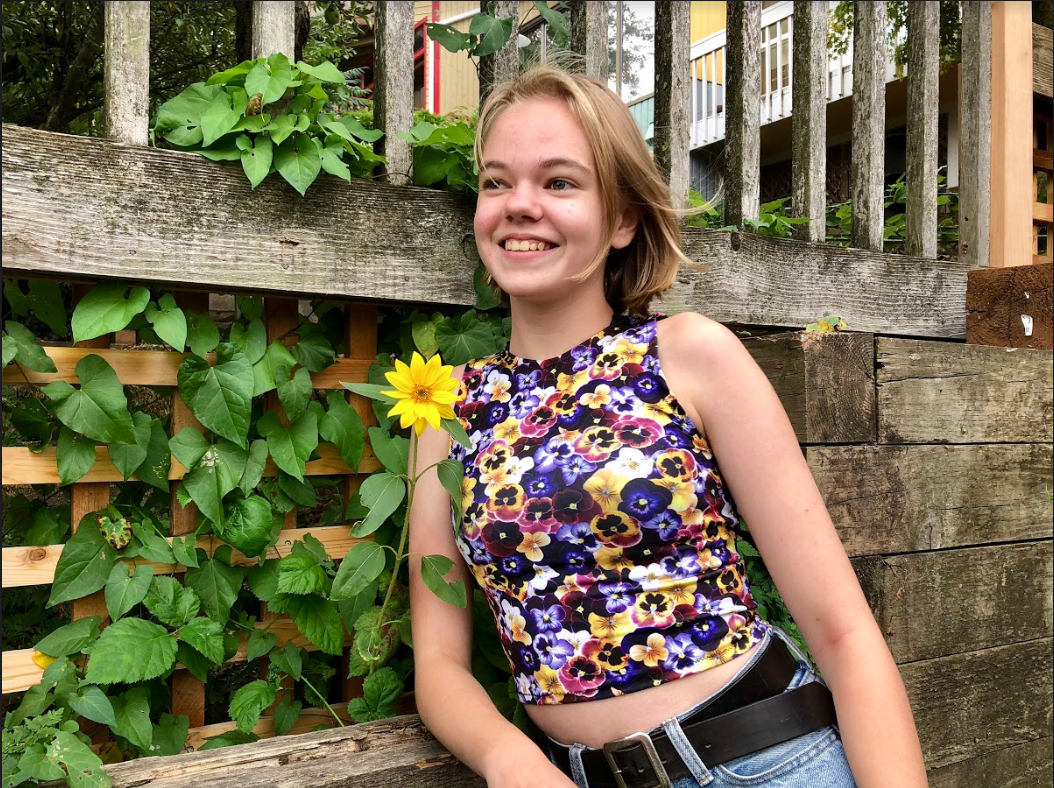 I was inspired to make this fabric when I went to the garden center and saw all the different flowers they had there. The fabric pattern is made using my photos of some of my favorite pansies.
I was inspired to make this fabric when I went to the garden center and saw all the different flowers they had there. The fabric pattern is made using my photos of some of my favorite pansies.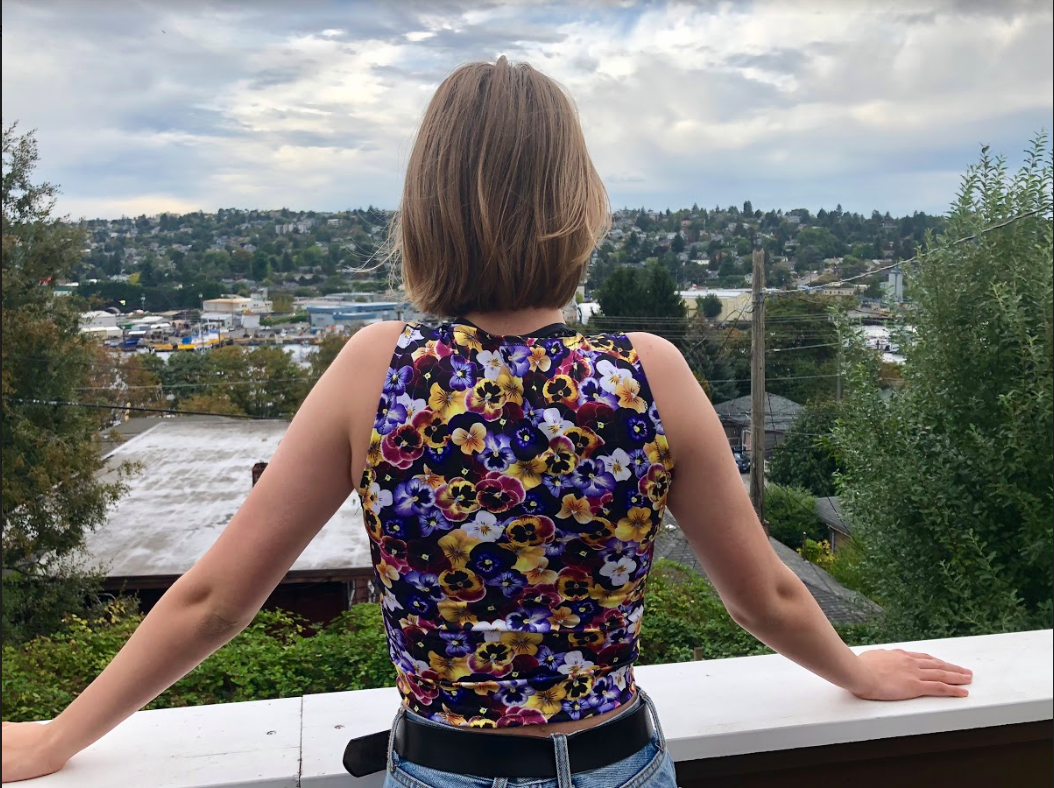 I had the fabric printed onto Sport Lycra in order to make my sister a crop top. I was a little worried about the print appearing faded or washing out, but these pictures were taken after the shirt had already been through the wash. The print is just as bright as when I got it!
I had the fabric printed onto Sport Lycra in order to make my sister a crop top. I was a little worried about the print appearing faded or washing out, but these pictures were taken after the shirt had already been through the wash. The print is just as bright as when I got it! 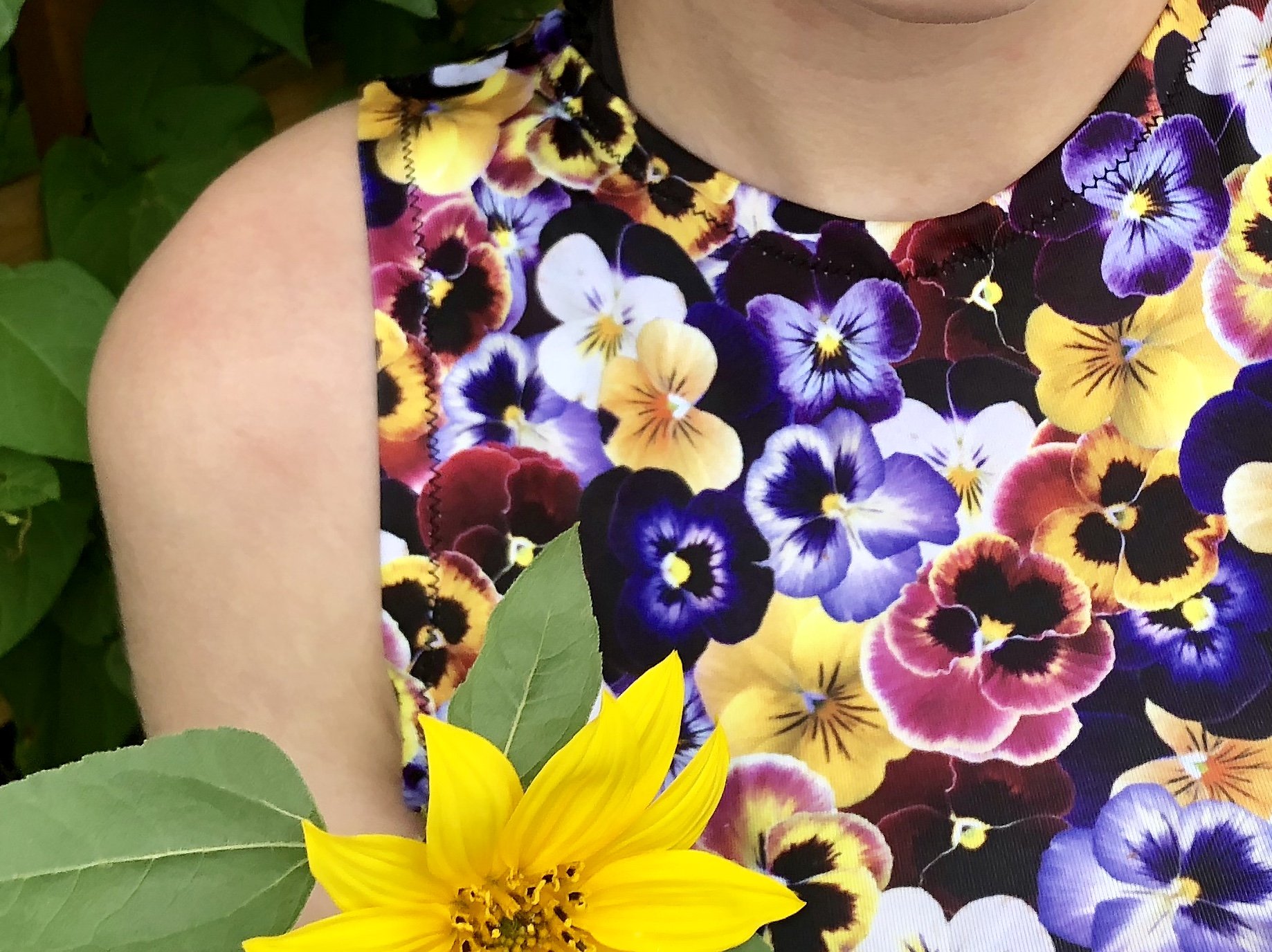 The shirt itself is simply two pieces of fabric zig zagged together at the sides and shoulders. The neck, armhole, and bottom hem are folded over and zig zagged in place.If anyone ends up using my pansy fabric, please send mp pictures! I'd love to see what you make!
The shirt itself is simply two pieces of fabric zig zagged together at the sides and shoulders. The neck, armhole, and bottom hem are folded over and zig zagged in place.If anyone ends up using my pansy fabric, please send mp pictures! I'd love to see what you make!
Elastigirl Cosplay
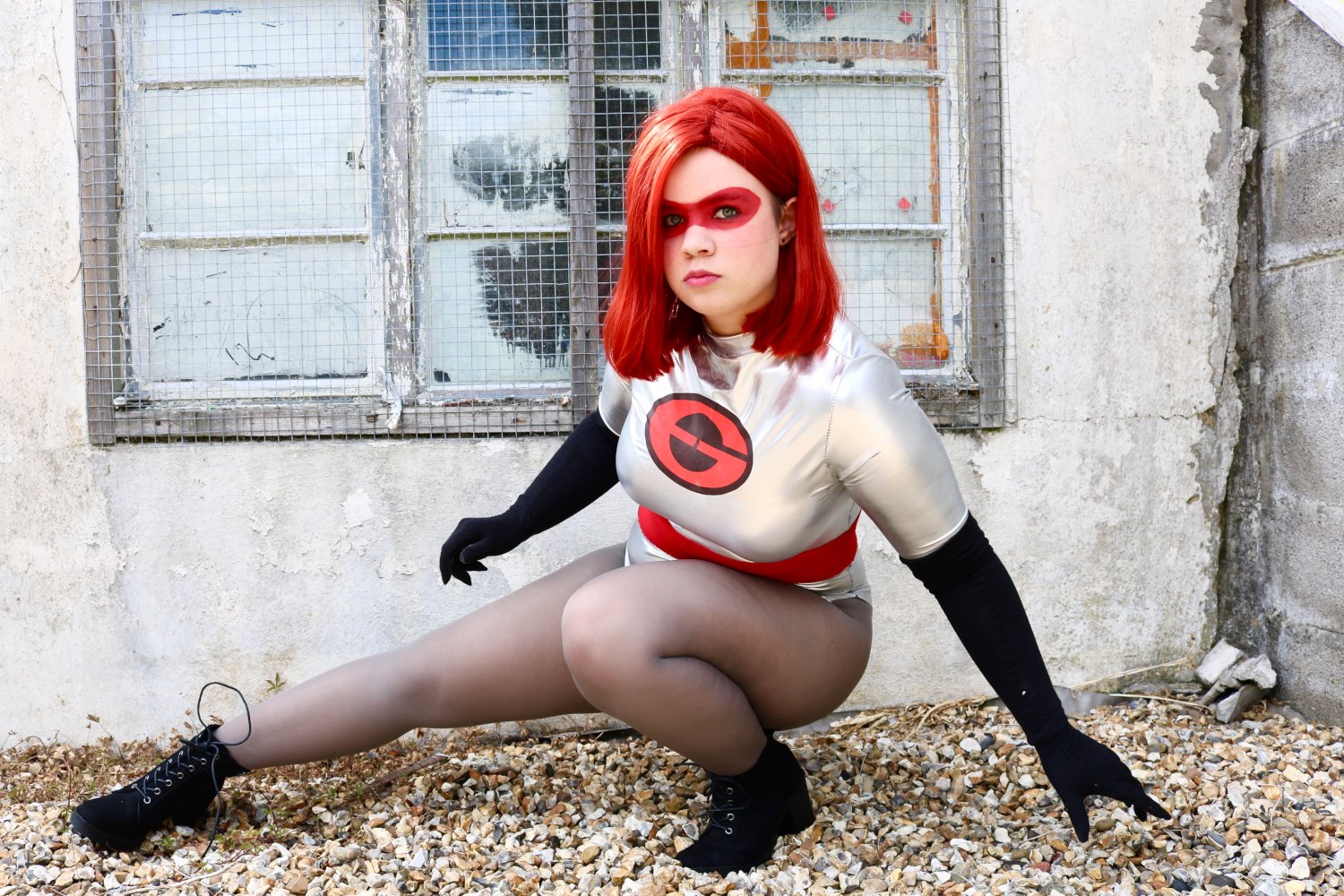 I just completed Elastigirl in time for LFCC! I watched the Incredibles 2 and immediately began working on this. This was a super spur of the moment cosplay, so a lot of the material was made from leftover fabrics. The silver was leftovers from Stocking, the belt is from an Amy Pond scrap, and the gloves are from an old pair of leggings. The whole thing was surprisingly easy to make.
I just completed Elastigirl in time for LFCC! I watched the Incredibles 2 and immediately began working on this. This was a super spur of the moment cosplay, so a lot of the material was made from leftover fabrics. The silver was leftovers from Stocking, the belt is from an Amy Pond scrap, and the gloves are from an old pair of leggings. The whole thing was surprisingly easy to make.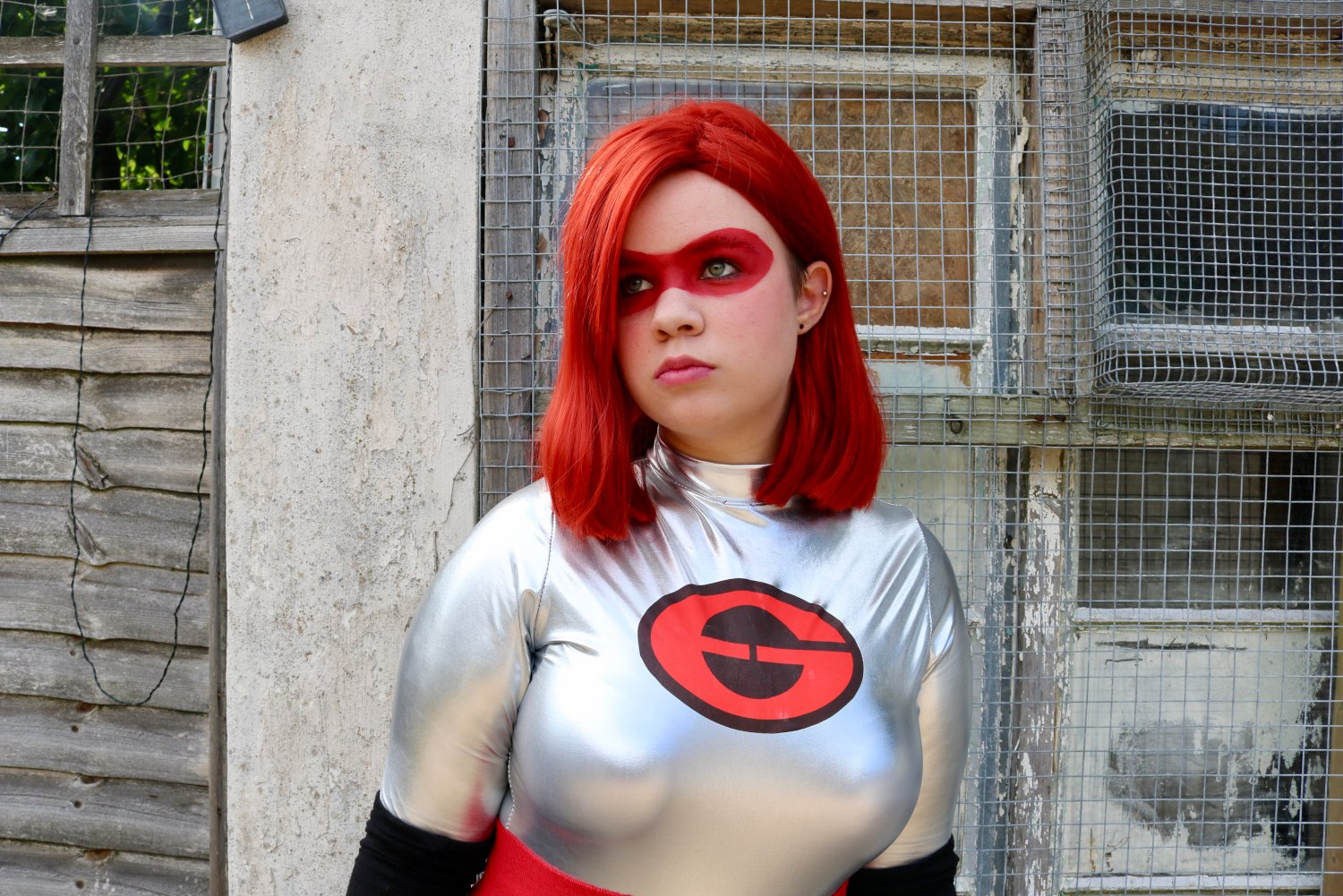 I made the leotard by looking closely at knit leotards and shirts that fit me and drawing that shape onto the fabric. This fabric is always a bit of a pain to work with because pins make holes in it, but I can get away with putting the pins through the seam allowance so it worked out. The fabric also doesn't fray, so I left the edges raw around the leg holes and wrists. I made the Elastigirl symbol in GIMP and applied it the same way that I applied the stripes to my 13th Doctor shirt. If you want your own, here's a link to the one I made.
I made the leotard by looking closely at knit leotards and shirts that fit me and drawing that shape onto the fabric. This fabric is always a bit of a pain to work with because pins make holes in it, but I can get away with putting the pins through the seam allowance so it worked out. The fabric also doesn't fray, so I left the edges raw around the leg holes and wrists. I made the Elastigirl symbol in GIMP and applied it the same way that I applied the stripes to my 13th Doctor shirt. If you want your own, here's a link to the one I made.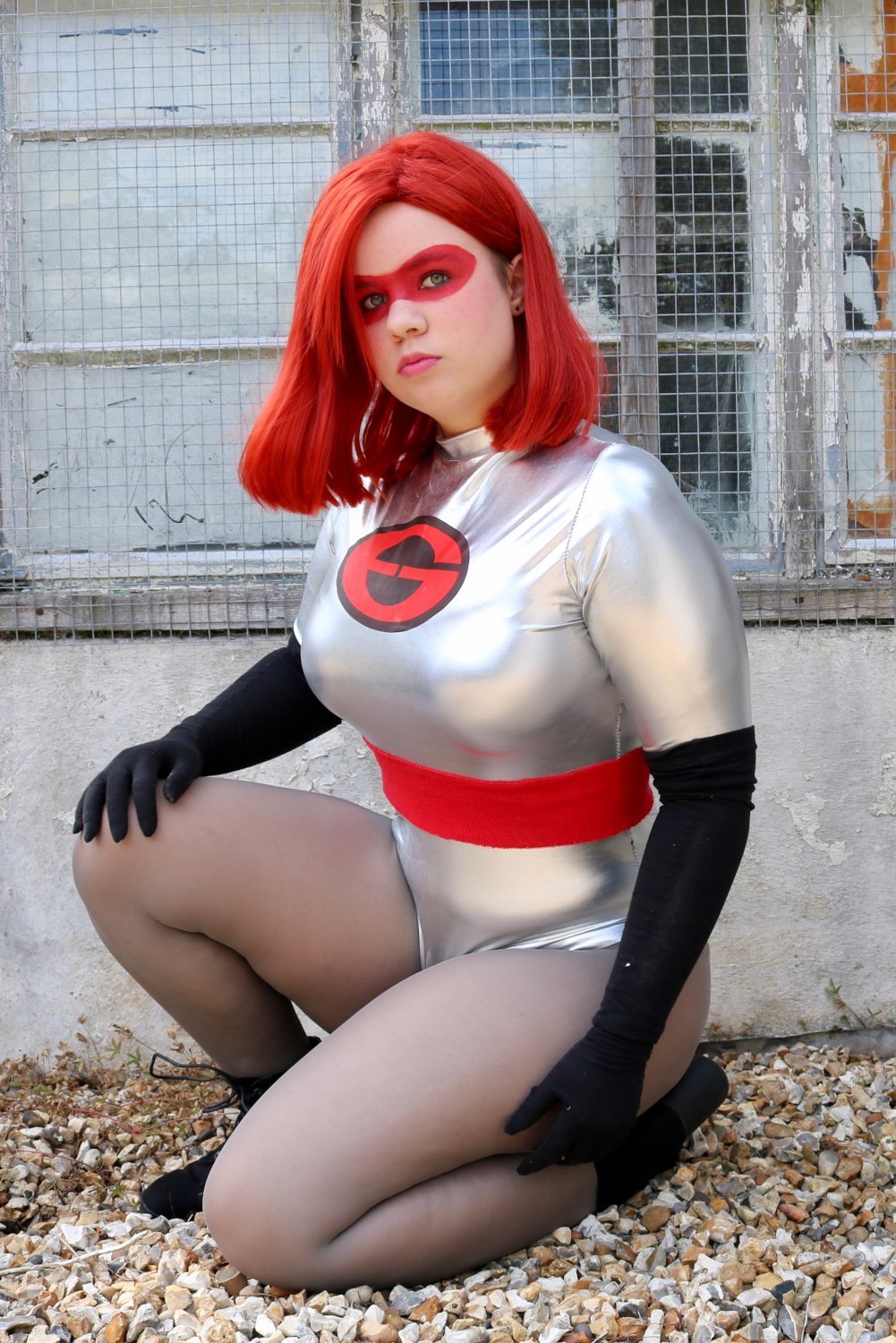 In the Incredibles 2, Elastigirl wears elbow length gloves and boots that go up to her thighs. I, unfortunately, was unable to find boots or gloves that were that long. I decided to make the gloves and leave the boots for now, the leotard was warm enough already and I wasn't about to add another layer. The gloves are made from an old pair of leggings that had ripped by tracing around my arm and sewing with a narrow zig-zag stitch. I do not recommend this fabric. They barely have any stretch to them, and because of this, I had to add length to the fingers for my long nails. They're also very difficult to get on, and the fabric rips very easily. It probably would have been worth buying fabric for these.
In the Incredibles 2, Elastigirl wears elbow length gloves and boots that go up to her thighs. I, unfortunately, was unable to find boots or gloves that were that long. I decided to make the gloves and leave the boots for now, the leotard was warm enough already and I wasn't about to add another layer. The gloves are made from an old pair of leggings that had ripped by tracing around my arm and sewing with a narrow zig-zag stitch. I do not recommend this fabric. They barely have any stretch to them, and because of this, I had to add length to the fingers for my long nails. They're also very difficult to get on, and the fabric rips very easily. It probably would have been worth buying fabric for these.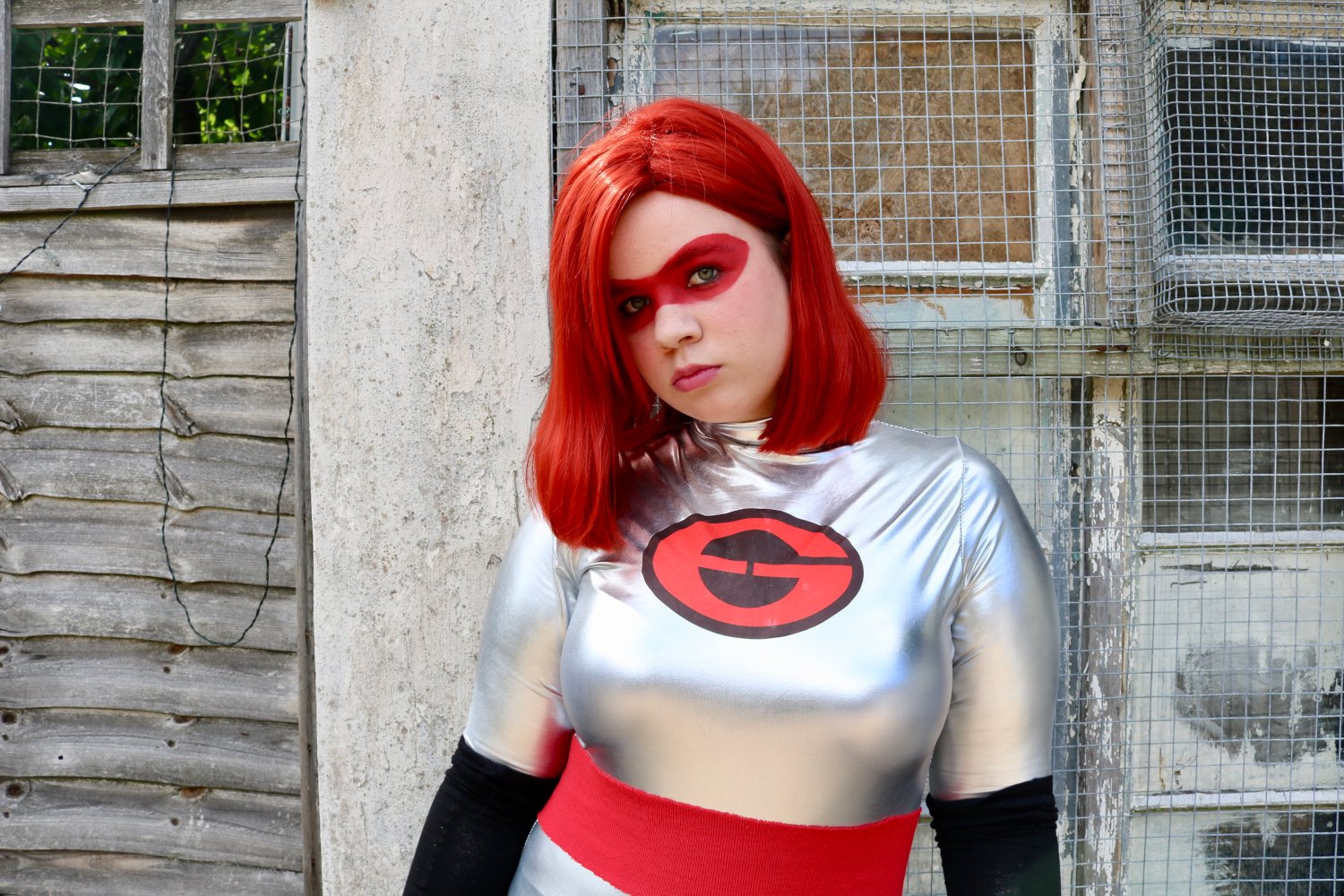 I recorded a video of how I did my makeup and styled the wig and will have that up next week!
I recorded a video of how I did my makeup and styled the wig and will have that up next week!
Razor's Hat from World Enough and Time
I was recently asked to make Razor's Hat from the Doctor Who episode World Enough and Time. I wrote up a pattern just in case anyone else was interested in making one for themself!What you'll need:
US size 6 needles (4.0 mm)
Double knit yarn
I used Stylecraft Special DK in Dark Brown Shade 1004I found that if you want to make your hat distressed in a similar way to the show, it is easier to prevent unraveling if you create the distressing as you go. I've included two versions of the hat, one with distressing and one without.
Unfamiliar terms explained:
DSPU: drop stitch and pull out stitches all the way to the brim, pick up a stitch on your left needle, ready to be worked as the next stitchCO 112 stitches in the round
With Distressing
Row 1-17: (K2, P2) 28 times
Row 18: (K2, P2) 2 times, K2, DSPU, P2, (K2, P2) 25 times [112 st]
Row 19-20: (K2, P2) 28 times
Row 21: K112
Row 22-33: (K2, P2) 28 times
Row 34: (K2, P2) 17 times, K2, DSPU, P2 (K2, P2) 10 times [112 st]
Row 35-40: (K2, P2) 28 times
Row 41: (K2, P2) 16 times, K1, DSPU, K1, P2 (K2, P2) 11 times [112 st]
Row 42-47: K112
Row 48: K71, DSPU, K 41 [112 st]
Row 49-51: K112
Without Distressing
Row 1-20: (K2, P2) 28 times
Row 21: K112
Row 22-41: (K2, P2) 28 times
Row 42-51: K112
Both Versions
Row 52-61: P112
Row 62-71: K112
Row 72-81: P112
Row 82-91: K112
Row 92-101: P112
Row 102-111: K112
Row 112-120: P112
Row 121: K2tog [56 st]
After working the last row, pull a piece of yarn through and pull as tight as possible. Weave in your ends and your hat is complete!
Lup from The Adventure Zone
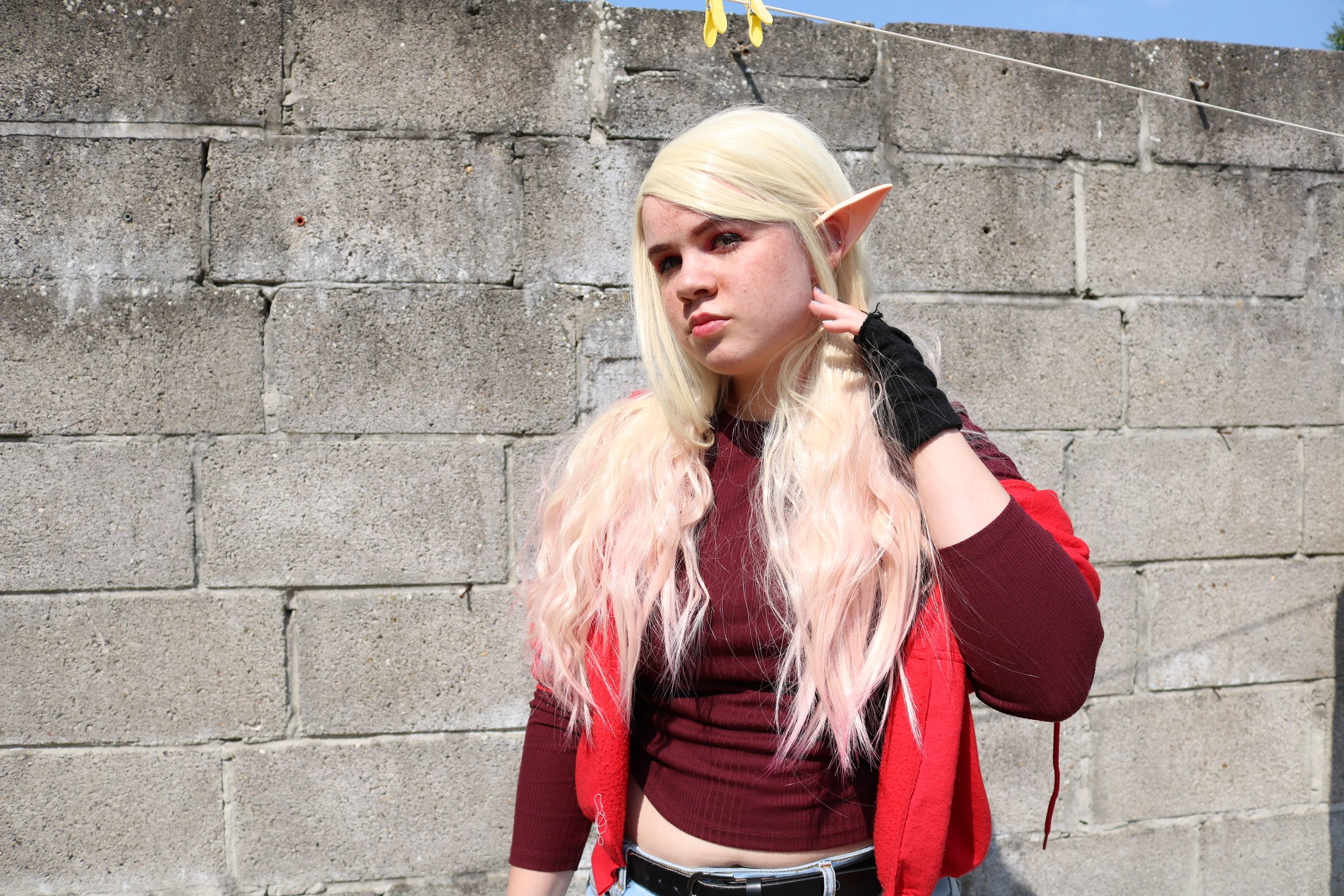 I recently completed a cosplay of the character Lup from the podcast The Adventure Zone. The Adventure Zone is an adventure comedy D&D podcast hosted by the McElroys. Lup is an accomplished elf wizard and is one of the first inter planar explorers.
I recently completed a cosplay of the character Lup from the podcast The Adventure Zone. The Adventure Zone is an adventure comedy D&D podcast hosted by the McElroys. Lup is an accomplished elf wizard and is one of the first inter planar explorers.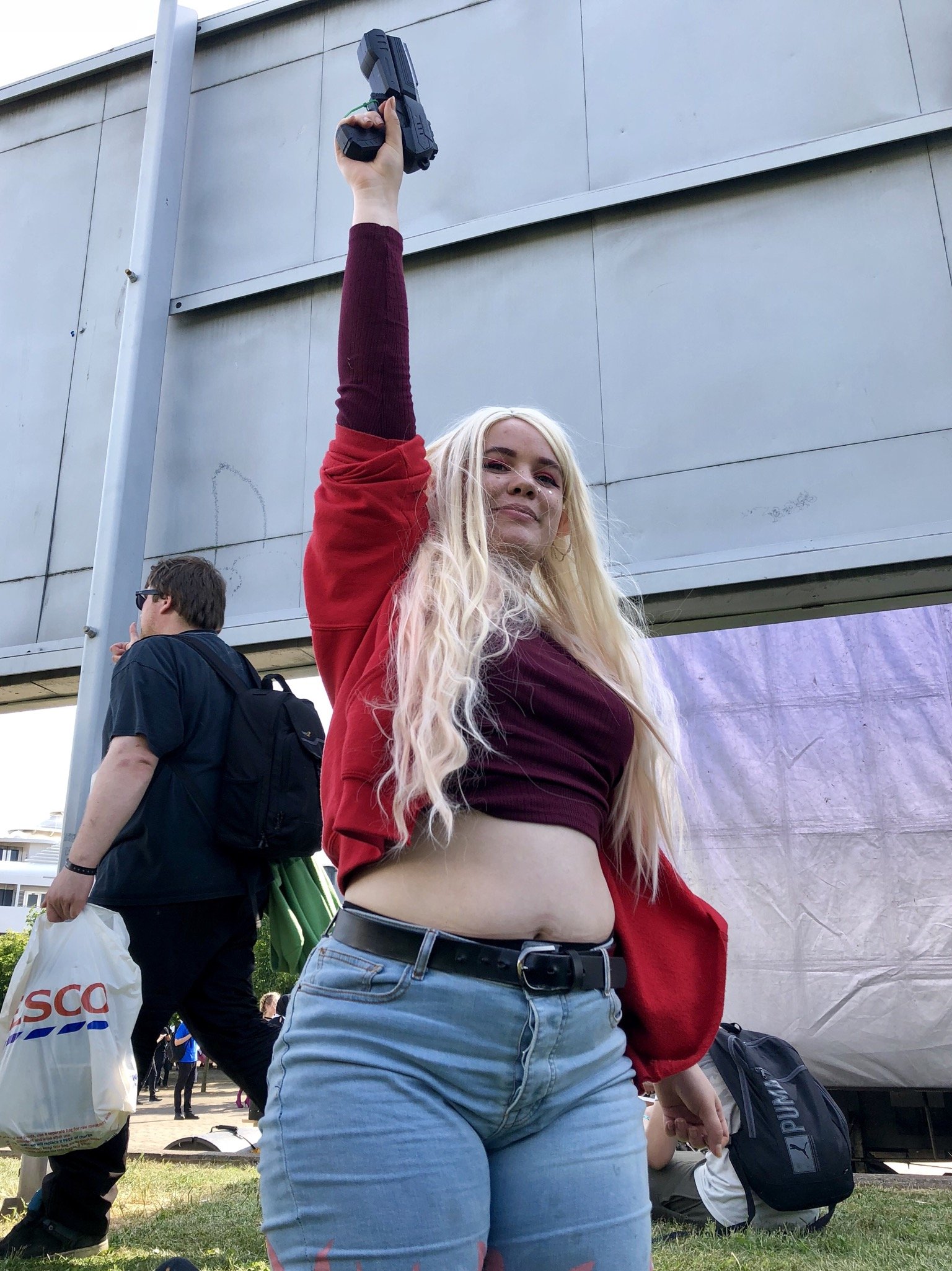 Since The Adventure Zone is solely audial, I based my costume on glowbat's art of the character. The maroon shirt and ears I bought specifically for this costume, while the earrings and shoes are items I already owned. I didn't have a sweatshirt that worked for this costume, but I did have a red pullover, so I cut it in half up the front and sewed the pockets closed. The gloves are just plain black gloves with the fingers cut off.
Since The Adventure Zone is solely audial, I based my costume on glowbat's art of the character. The maroon shirt and ears I bought specifically for this costume, while the earrings and shoes are items I already owned. I didn't have a sweatshirt that worked for this costume, but I did have a red pullover, so I cut it in half up the front and sewed the pockets closed. The gloves are just plain black gloves with the fingers cut off.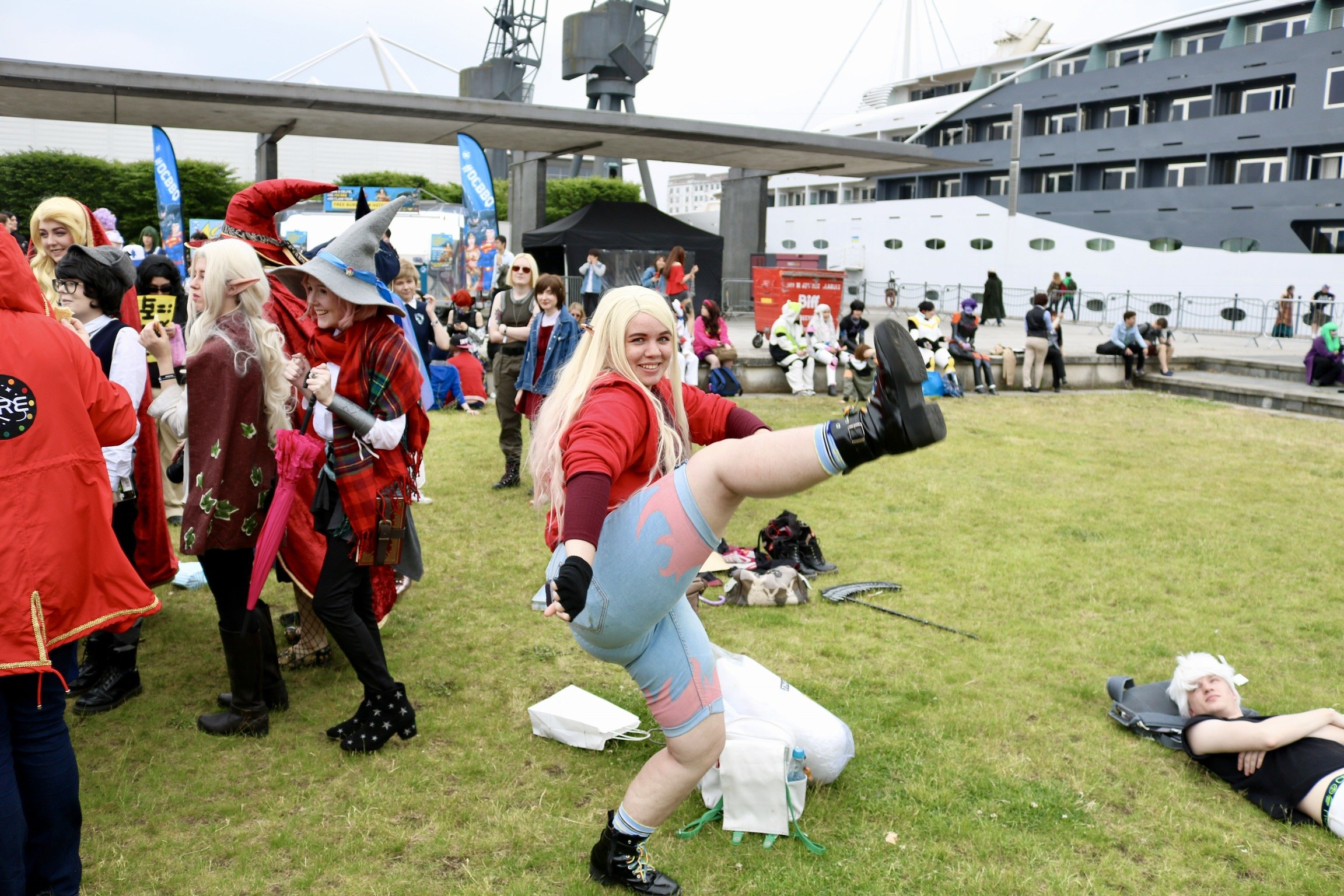 The wig and shorts were probably the most time intensive part of the wold project. I dip dyed the wig using sharpie ink and rubbing alcohol in a spray bottle, which I documented here. I made the shorts by cutting a pair of jeans at the knee, painting on the flames, and rolling up the raw edge of the shorts. The paint I used for the flames is a 50/50 mix of acrylic paint (for color) and acrylic fabric medium (to set the paint into the fabric). I actually really like these shorts, and have been wearing them out of cosplay quite a bit!
The wig and shorts were probably the most time intensive part of the wold project. I dip dyed the wig using sharpie ink and rubbing alcohol in a spray bottle, which I documented here. I made the shorts by cutting a pair of jeans at the knee, painting on the flames, and rolling up the raw edge of the shorts. The paint I used for the flames is a 50/50 mix of acrylic paint (for color) and acrylic fabric medium (to set the paint into the fabric). I actually really like these shorts, and have been wearing them out of cosplay quite a bit!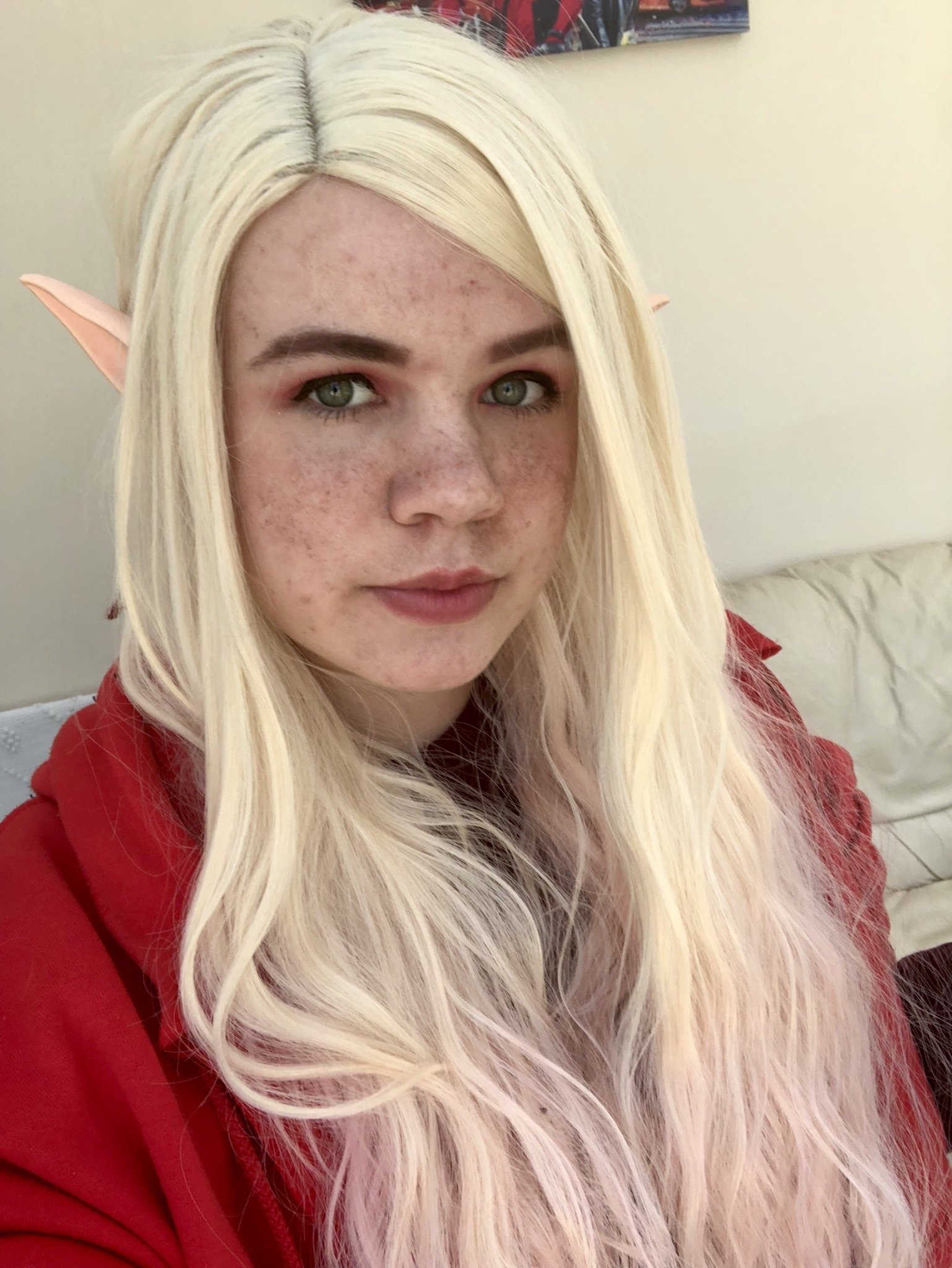 It was so bright the whole weekend, all the makeup I did didn't show up an camera! Luckily I took this picture of my makeup inside, where all the freckles show up! Unfortunately, in this image the ears I bought are very obviously a different color than my skin. Whoops!
It was so bright the whole weekend, all the makeup I did didn't show up an camera! Luckily I took this picture of my makeup inside, where all the freckles show up! Unfortunately, in this image the ears I bought are very obviously a different color than my skin. Whoops!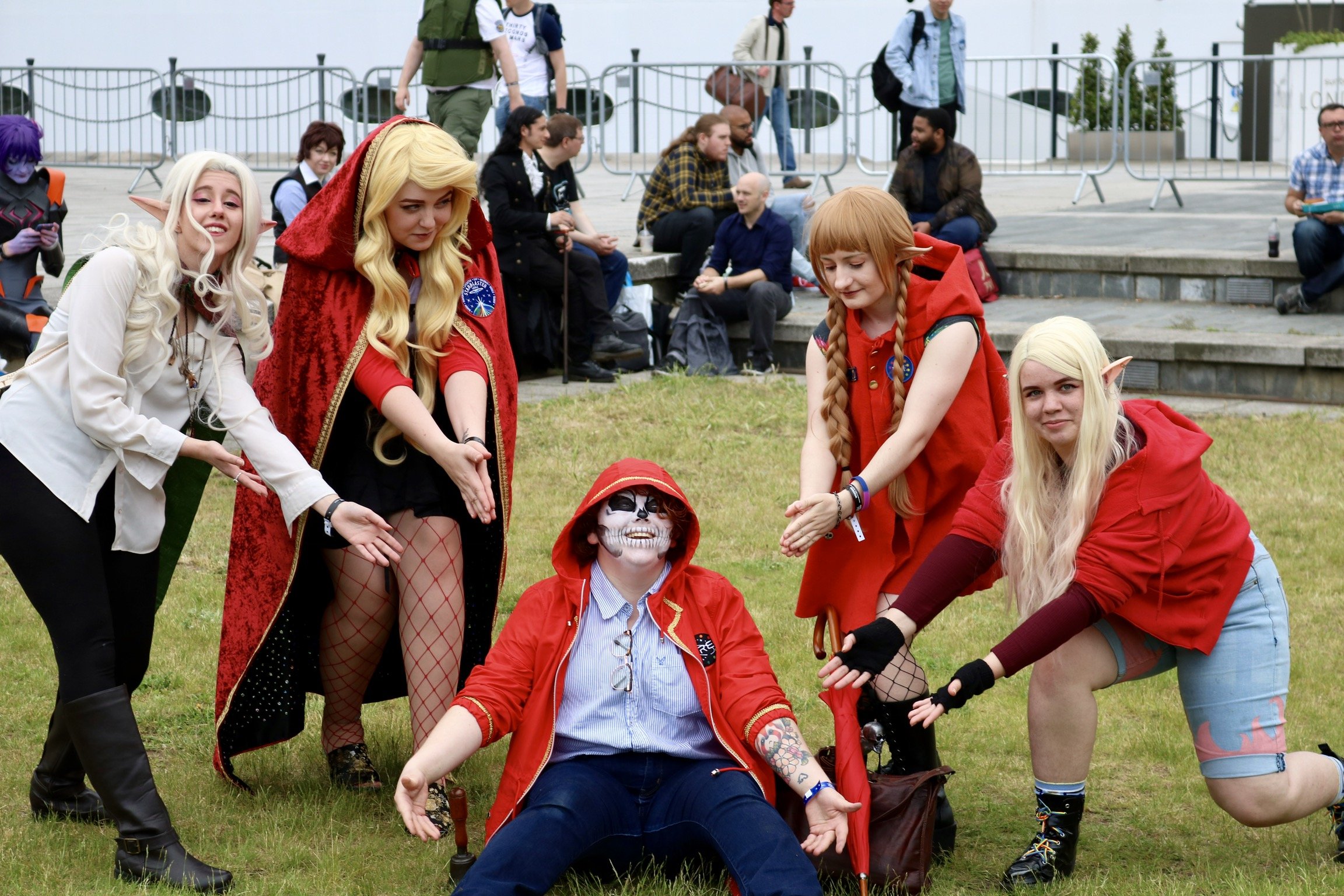 I wore Lup to London MCM May on both the Friday and Saturday. It was super cool to get to go to meet ups on both days and see everyone's interpretations of the characters. I'm looking forward to changing pieces of this cosplay and wearing it again to a different convention!
I wore Lup to London MCM May on both the Friday and Saturday. It was super cool to get to go to meet ups on both days and see everyone's interpretations of the characters. I'm looking forward to changing pieces of this cosplay and wearing it again to a different convention!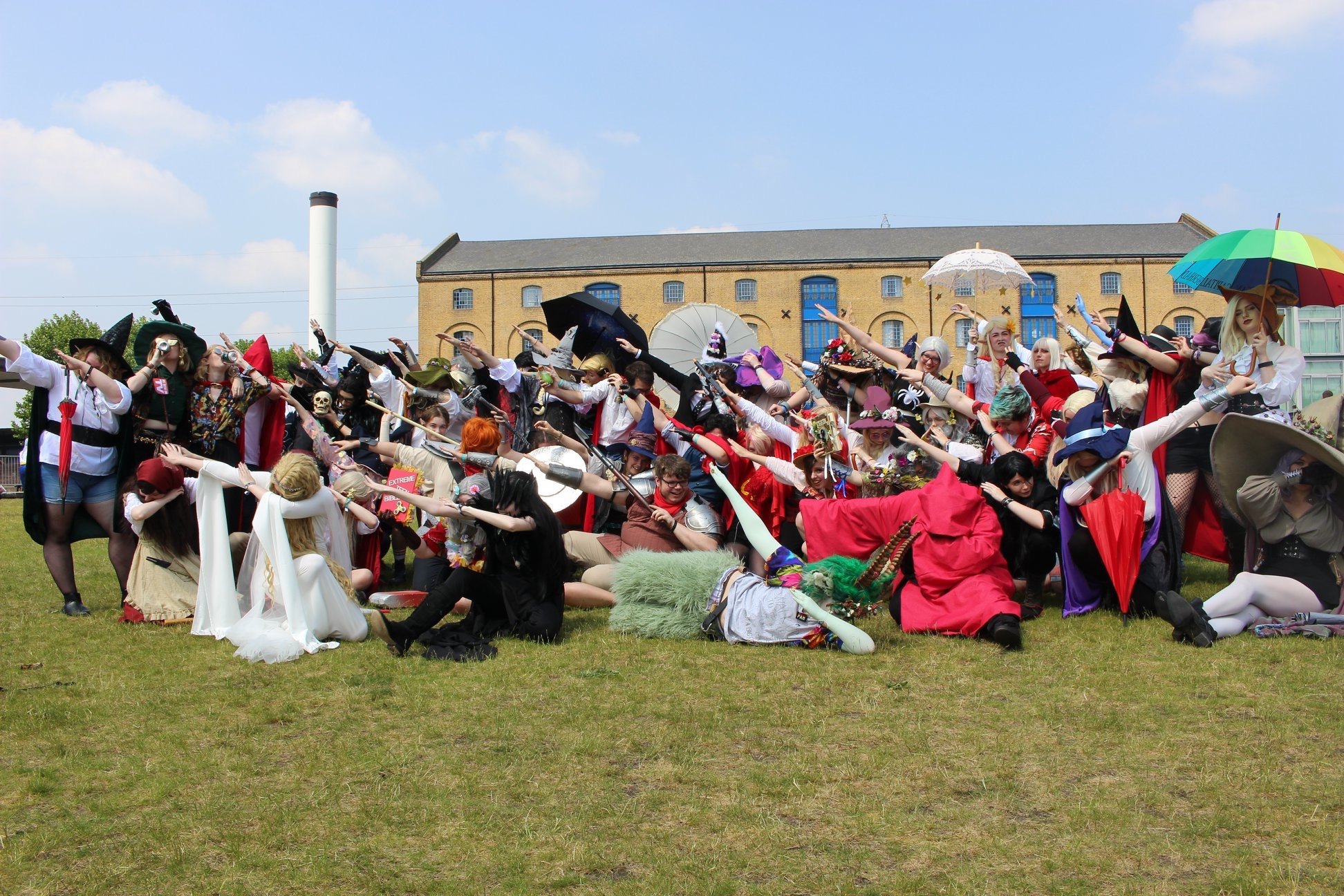
13th Doctor Striped Socks
These socks were super fun to make, so I wrote up the pattern and made a video tutorial! Let me know what you think, and be sure to let me know if you make a pair!
https://youtu.be/iFmZZbX1GSE
Materials:
Special Stylecraft Double Knit in Lapis
Special Stylecraft Double Knit in Duck Egg
3.25 mm Knitting Needles (US3/UK11)
Pattern:
Cast on 60 stitches in Dark Blue
K1P1 all the way around for 8 rows
K all the way around for 8 rows
*Switch to Light Blue, K all the way around for 4 rows
Switch to Dark Blue, K all the way around for 4 rows
Repeat from * four times, making a total of 5 Dark Blue and 5 Light Blue stripes
Switch to Light Blue, K all the way around for one and a half rowsShift needles so that you can start the heel from the center back of the work
HEEL & TOE
K 15 stitches, turn
Row 1: sl st, P29, turn
Row 2: sl st, K28, turn
Row 3: sl st, P27, turn
Row 4: sl st, K26, turn
Row 5: sl st, P25, turn
Row 6: sl st, K24, turn
Row 7: sl st, P23, turn
Row 8: sl st, K22, turn
Row 9: sl st, P21, turn
Row 10: sl st, K20, turn
Row 11: sl st, P19, turn
Row 12: sl st, K18, turn
Row 13: sl st, P17, turn
Row 14: sl st, K16, turn
Row 15: sl st, P15, turn
Row 16: sl st, K14, pick up stitch from between previous worked stitch and next stitch on left needle (denoted as m1), k2tog, turn
Row 17: P15, m1, p2tog, turn
Row 18: K16, m1, k2tog, turn
Row 19: P17, m1, p2tog, turn
Row 20: K18, m1, k2tog, turn
Row 21: P19, m1, p2tog, turn
Row 22: K20, m1, k2tog, turn
Row 23: P21, m1, p2tog, turn
Row 24: K22, m1, k2tog, turn
Row 25: P23, m1, p2tog, turn
Row 26: K24, m1, k2tog, turn
Row 27: P25, m1, p2tog, turn
Row 28: K26, m1, k2tog, turn
Row 29: P27, m1, p2tog, turn
Row 30: K28, m1, k2tog, turn
Row 31: P29, m1, p2tog, turn
HEEL ONLY
Row 32: K 15
Adjust stitches so that you can continue working with your Light Blue yarn where you left off. Complete that row in knit stitch, and then do two more rows of knit stitch in Light Blue.
*Switch to Dark Blue, K all the way around for 4 rowsSwitch to Light Blue, P all the way around for 4 rows
Repeat from * until your sock is the right length for your foot.
For reference, I had a total of 5 Dark Blue and 5 Light Blue stripes for my UK size 5 feet.
Refer back to the heel instructions and work the toe the same as the heel.
Complete the sock with kitchener stitch and weave in your ends.
Tada! You now have your own pair of 13th Doctor Socks!
Homeward Bound Fingerless Mittens
 When I first saw this lovely brown yarn, I knew immediately that I wanted to make some sort of glove or mitten for myself from them. My aunt got the yarn from a place called Pacesetter Alpacas in Beloit, Wisconsin. It's a wonderfully soft yarn, and I actually got to meet the alpaca from which the wool was collected! I unfortunately lost the label for this yarn, but if I remember correctly, it was a blend of two different kinds of alpacas.
When I first saw this lovely brown yarn, I knew immediately that I wanted to make some sort of glove or mitten for myself from them. My aunt got the yarn from a place called Pacesetter Alpacas in Beloit, Wisconsin. It's a wonderfully soft yarn, and I actually got to meet the alpaca from which the wool was collected! I unfortunately lost the label for this yarn, but if I remember correctly, it was a blend of two different kinds of alpacas.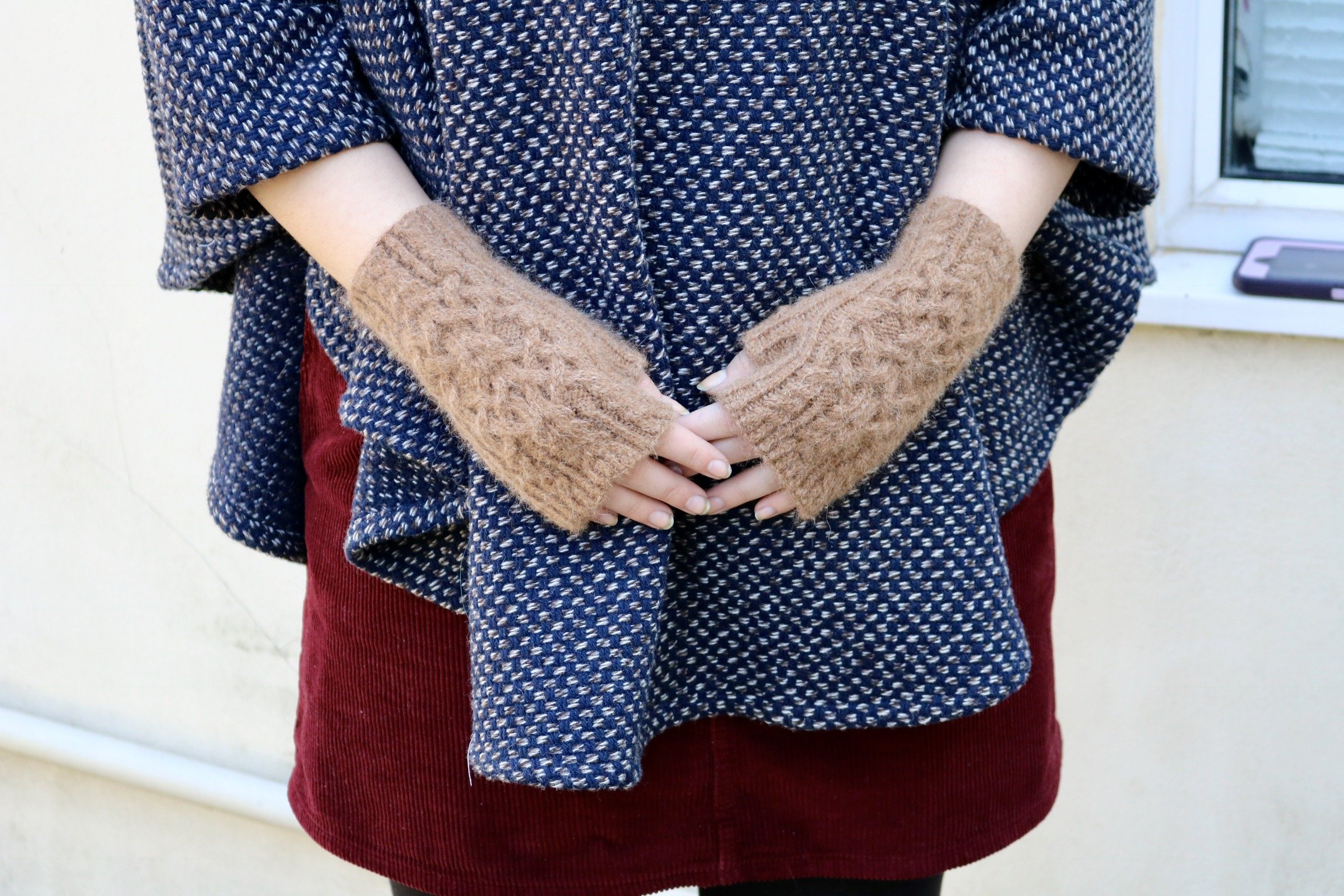 Because this yarn was so nice, I wanted to pick the perfect pattern. After much searching, I settled on the Homeward Bound Mitts. The cables on the backs of these mittens caught my eye immediately. I hadn't knit anything with particularly complicated cables before and this looked like a good way to challenge myself.
Because this yarn was so nice, I wanted to pick the perfect pattern. After much searching, I settled on the Homeward Bound Mitts. The cables on the backs of these mittens caught my eye immediately. I hadn't knit anything with particularly complicated cables before and this looked like a good way to challenge myself.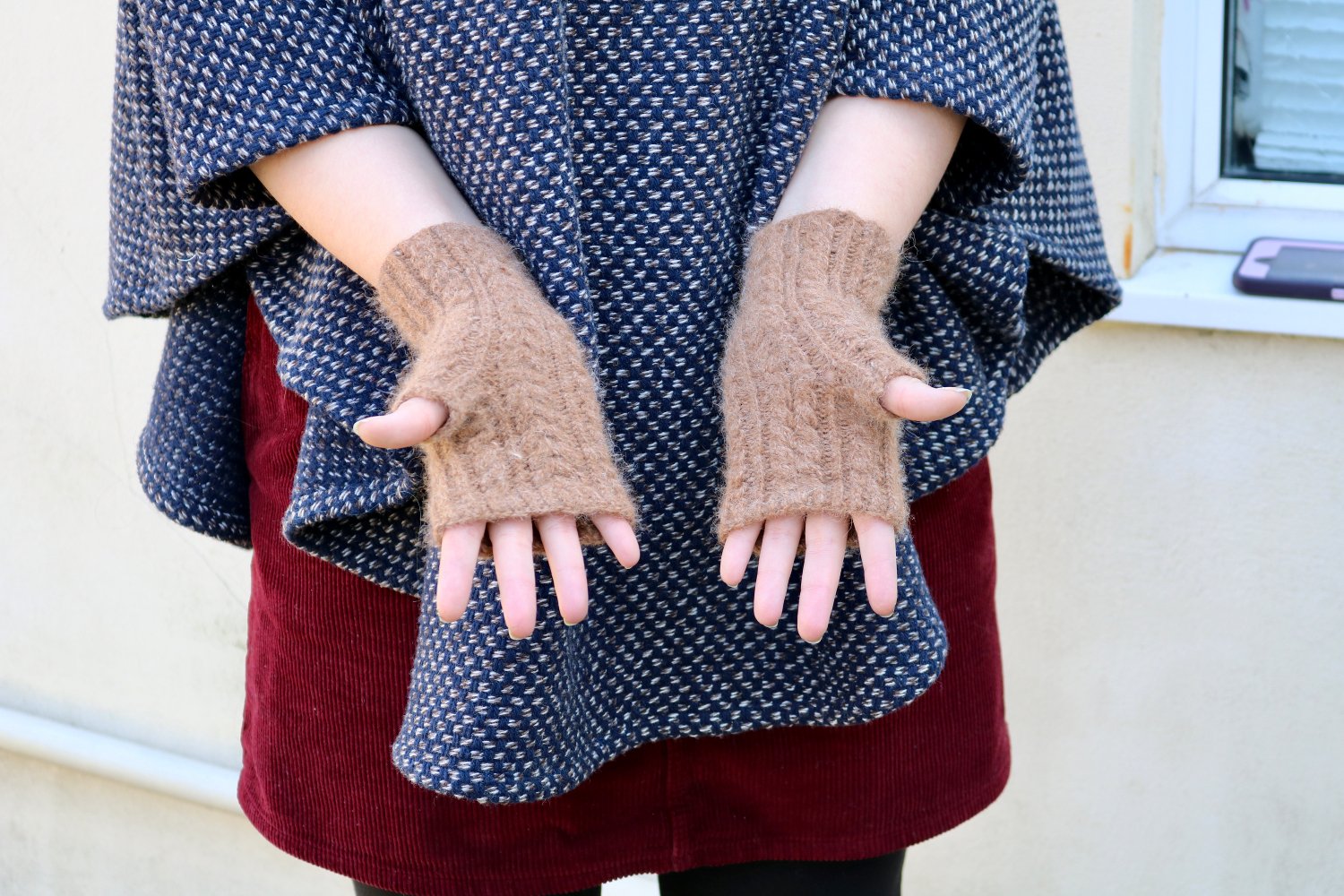 I made these mittens for myself in size 1 using 3.25 mm/US size 3/UK size 10 DPNs. Because I wasn't planning on switching needles between the wrist and hand of the glove I chose a size between the two recommended in the pattern. I was a little concerned that they wouldn't fit properly, but it turned out fine By mistake, I left off the rib on the bottom of the mittens, but I don't think it's too noticeable.
I made these mittens for myself in size 1 using 3.25 mm/US size 3/UK size 10 DPNs. Because I wasn't planning on switching needles between the wrist and hand of the glove I chose a size between the two recommended in the pattern. I was a little concerned that they wouldn't fit properly, but it turned out fine By mistake, I left off the rib on the bottom of the mittens, but I don't think it's too noticeable. 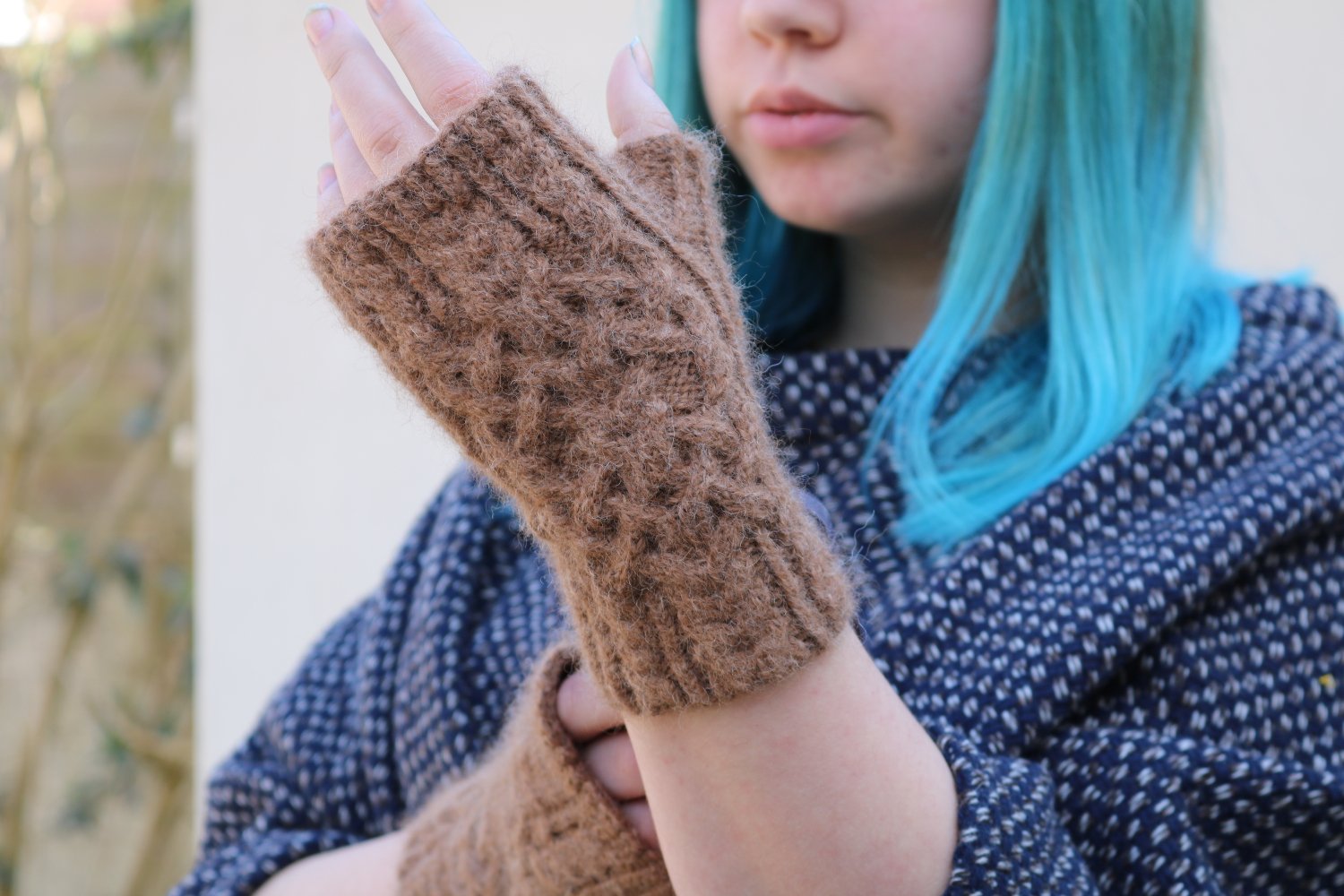 The pattern for these mittens was really well written, and included charts for all the cabling sections. I had never made a thumb before, and this pattern described how to knit one well enough that I made almost no mistakes! I love these mittens, and I'm almost tempted to make myself a pair in every color.
The pattern for these mittens was really well written, and included charts for all the cabling sections. I had never made a thumb before, and this pattern described how to knit one well enough that I made almost no mistakes! I love these mittens, and I'm almost tempted to make myself a pair in every color.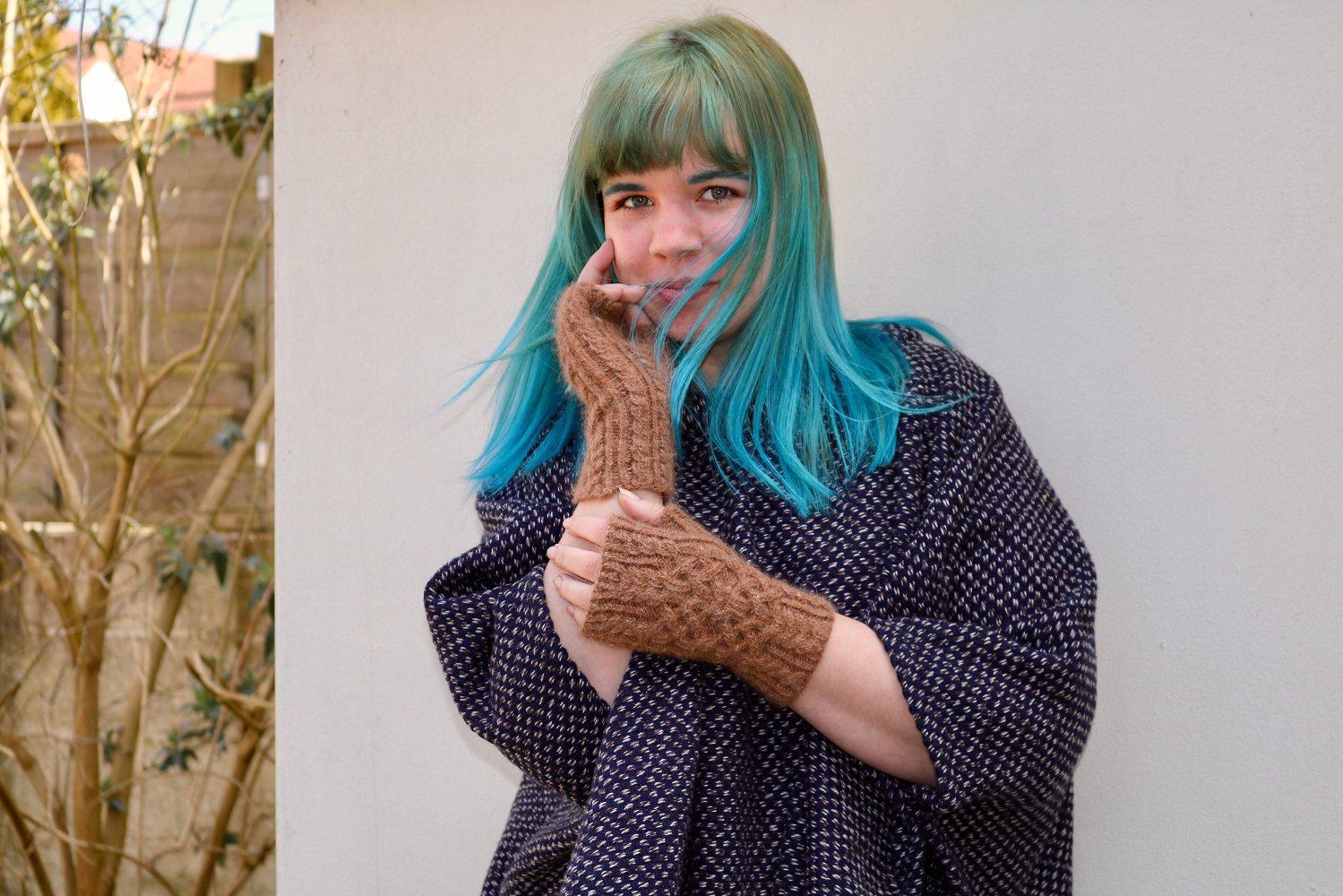
13th Doctor Stripe Shirt
https://www.youtube.com/watch?v=HukW_UES1IwI decided to try something a little different and branch off into video! This is a video about how I made a shirt for my 13th Doctor cosplay.If you're making this yourself, you will need:
- Navy Scoop Neck T-Shirt (I found mine in Primark)
- Dark Colour Transfer Papers
- Stripe Pattern
- Iron
- Ironing Board
- Scissors
- Pins/Chalk/Tape
This is my first time making a tutorial video, so any feedback is appreciated!

